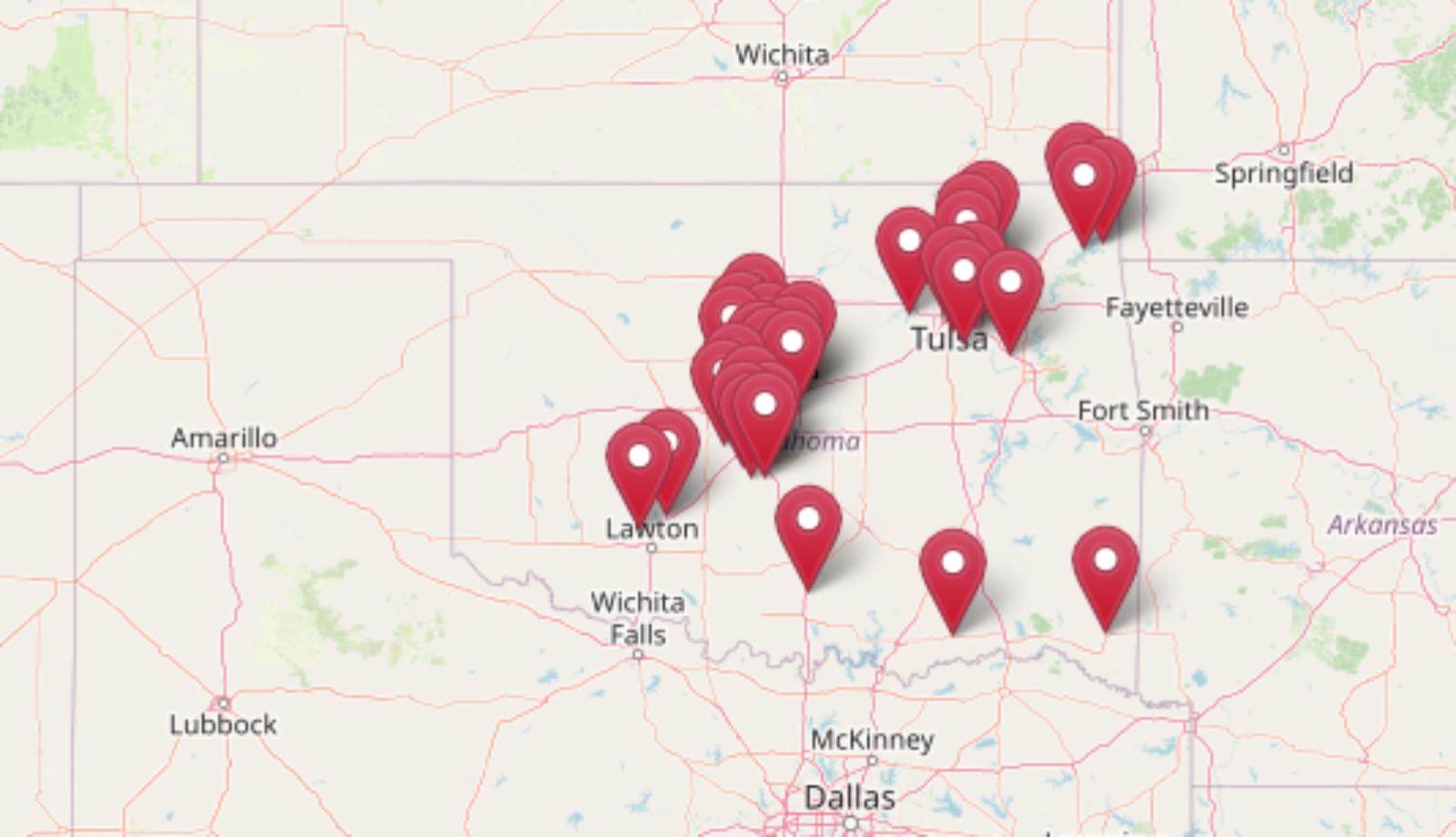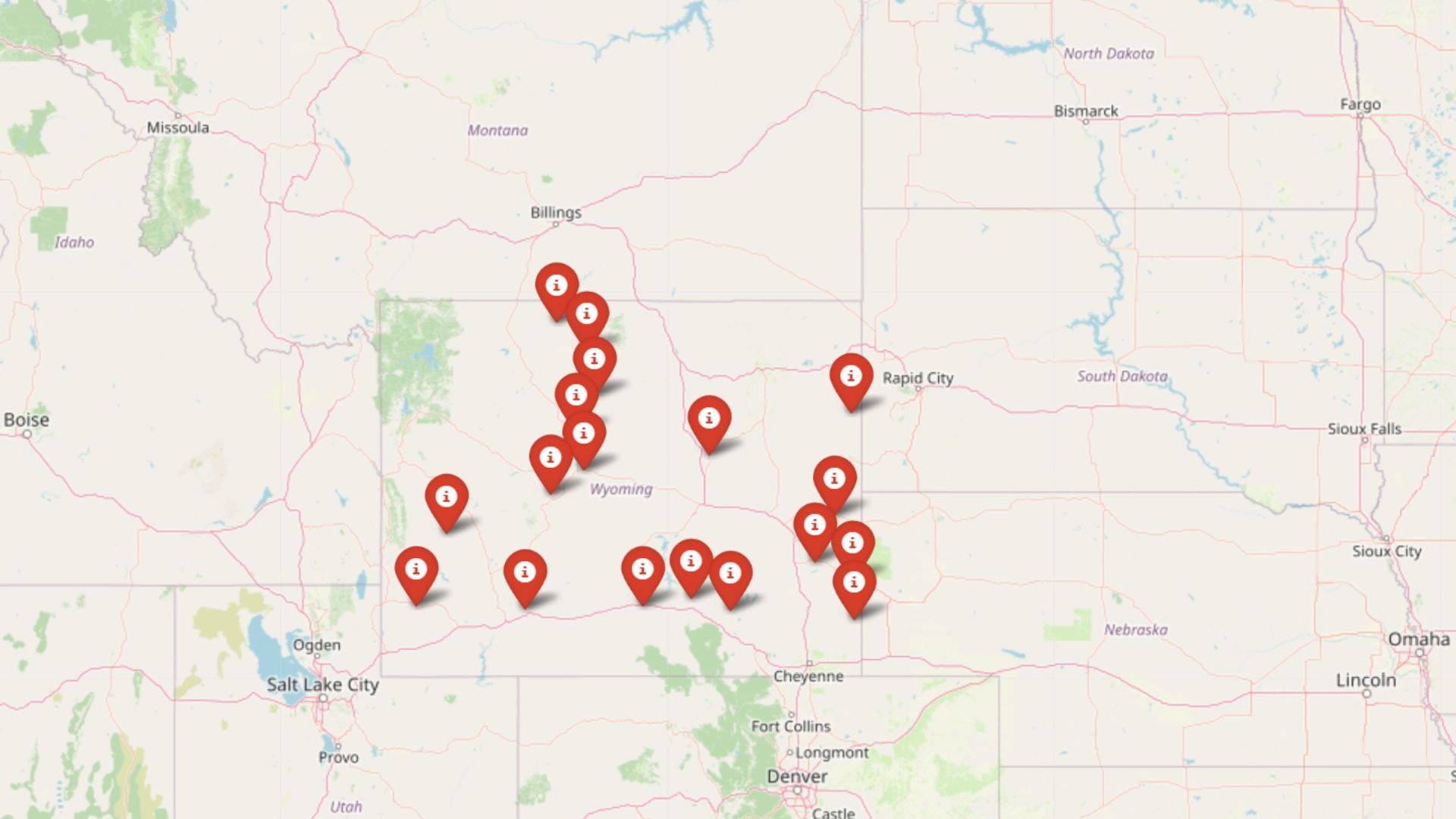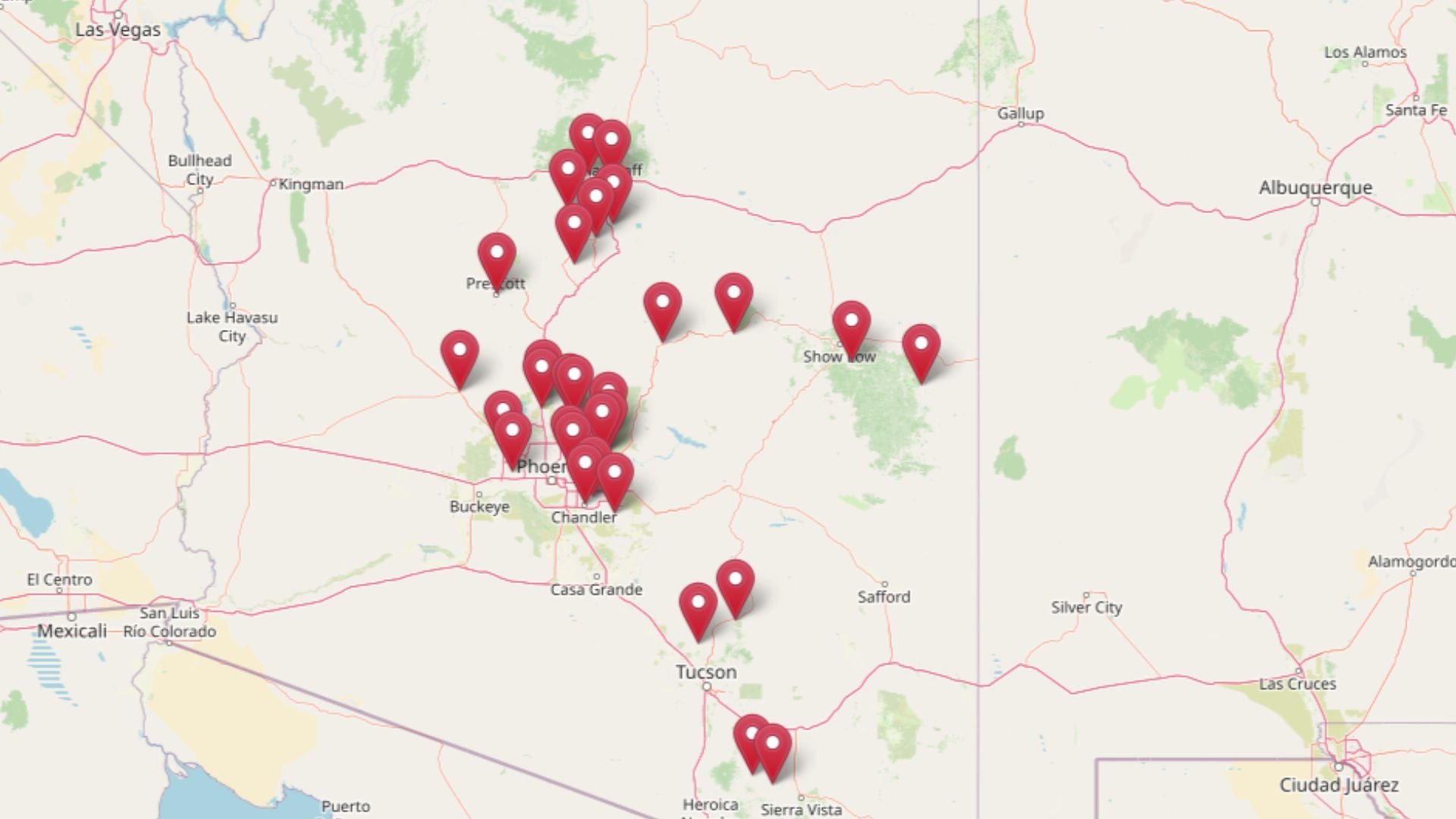
Based on the latest Zillow Home Value Index data, these Arizona towns represent the state’s most expensive real estate markets. Each community shows not only current high values but also significant long-term appreciation that reflects sustained demand. From desert luxury enclaves to mountain retreats, these 30 towns have experienced remarkable price growth over the past 15 years.
The data reveals fascinating trends across Arizona’s diverse geography, with Phoenix-area suburbs and luxury resort communities leading the charge. Whether you’re looking to understand investment potential or curious about Arizona’s premium real estate landscape, these rankings provide insight into where home values have climbed highest—and what drives these impressive price points.
30. Star Valley – 136% Home Price Increase Since 2010
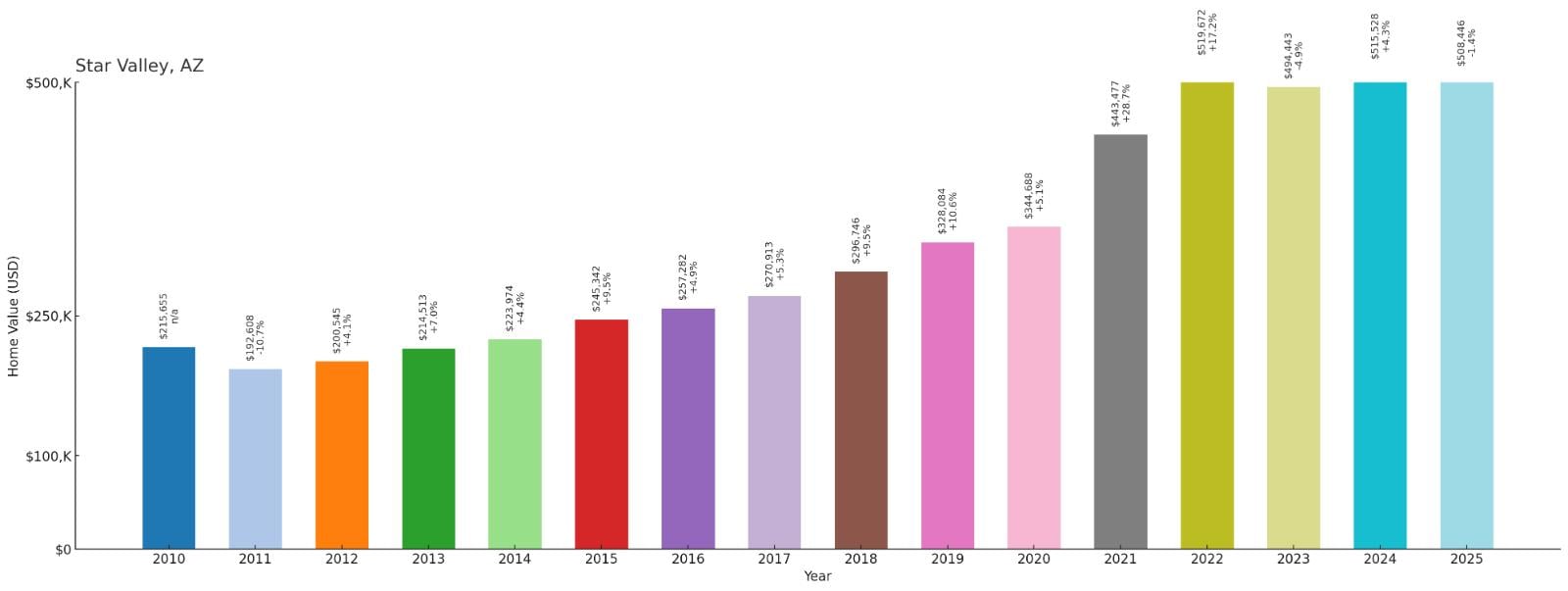
- 2010: $215,655
- 2011: $192,608
- 2012: $200,545
- 2013: $214,513
- 2014: $223,974
- 2015: $245,342
- 2016: $257,282
- 2017: $270,913
- 2018: $296,746
- 2019: $328,084
- 2020: $344,688
- 2021: $443,477
- 2022: $519,672
- 2023: $494,443
- 2024: $515,528
- 2025: $508,446
Star Valley shows impressive growth despite early volatility, with home values more than doubling from their 2010 starting point. The biggest surge came during the pandemic years of 2021-2022, when prices jumped nearly 40% in just two years. Current values of around $508,000 reflect some market correction from the 2022 peak but remain well above historic norms.
Why Star Valley?
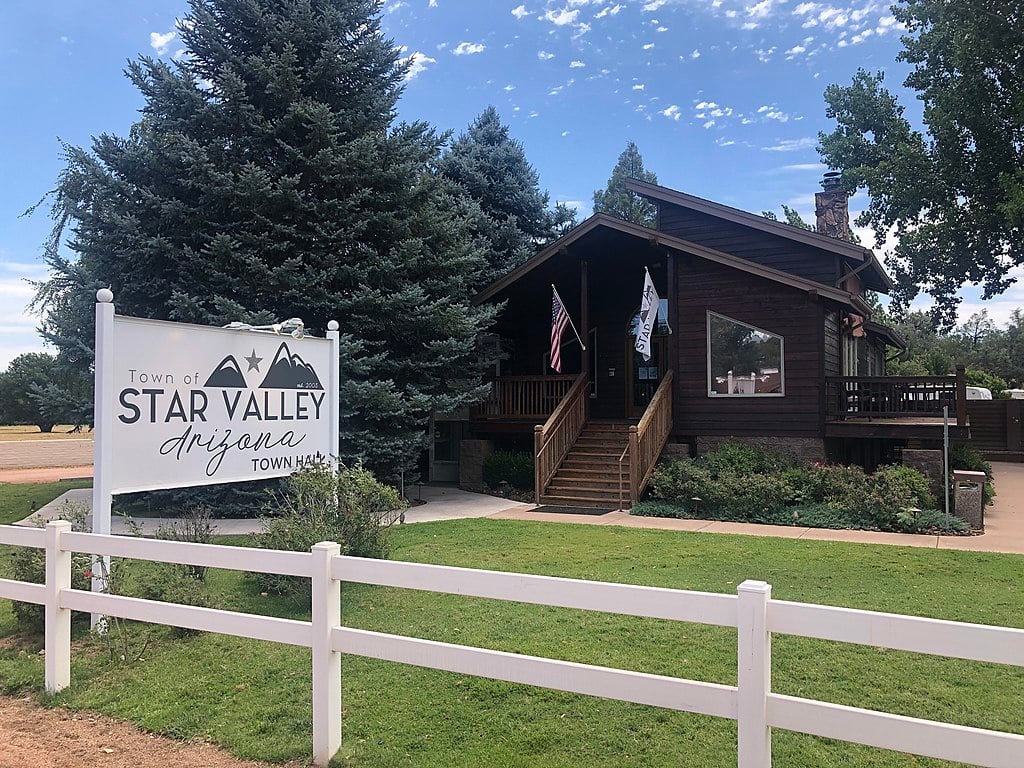
Why are people willing to pay so much to live here? What’s special about it?
Star Valley attracts buyers seeking rural tranquility within commuting distance of Phoenix’s western suburbs. The community offers larger lots, horse properties, and a small-town atmosphere that appeals to families wanting space and privacy. Its location in the Agua Fria River valley provides natural beauty and recreational opportunities while maintaining accessibility to urban amenities.
The area’s relatively affordable entry point compared to other Arizona luxury markets makes it attractive to first-time rural property buyers. Star Valley also benefits from its proximity to both Phoenix job markets and outdoor recreation areas, creating a compelling balance for lifestyle-focused homebuyers.
How Star Valley Rose to Prominence
Star Valley emerged as Phoenix’s metropolitan area expanded westward, transforming from an agricultural community into a rural-suburban hybrid that preserved its country character. Originally settled by ranchers and farmers, the area maintained its agricultural roots longer than many surrounding communities. The town incorporated in 1999, reflecting residents’ desire to maintain local control over development.
The community’s growth accelerated during the 2000s housing boom as buyers sought affordable alternatives to established Phoenix suburbs. Star Valley’s large lots and rural zoning attracted horse enthusiasts, custom home builders, and families seeking a different pace of life while remaining within the metropolitan area’s economic sphere.
3 Interesting Tidbits
1. Horse Country – Star Valley maintains an equestrian-friendly culture with many properties featuring barns, riding arenas, and horse trails that preserve the area’s ranch heritage.
2. River Valley Setting – The town sits in the scenic Agua Fria River valley, providing natural beauty and wildlife viewing opportunities that enhance property values.
3. Desert Preserve Access – Residents enjoy proximity to thousands of acres of preserved desert land and state trust property perfect for hiking, off-road recreation, and enjoying Arizona’s natural landscapes.
29. Bellemont – 174% Home Price Increase Since 2013
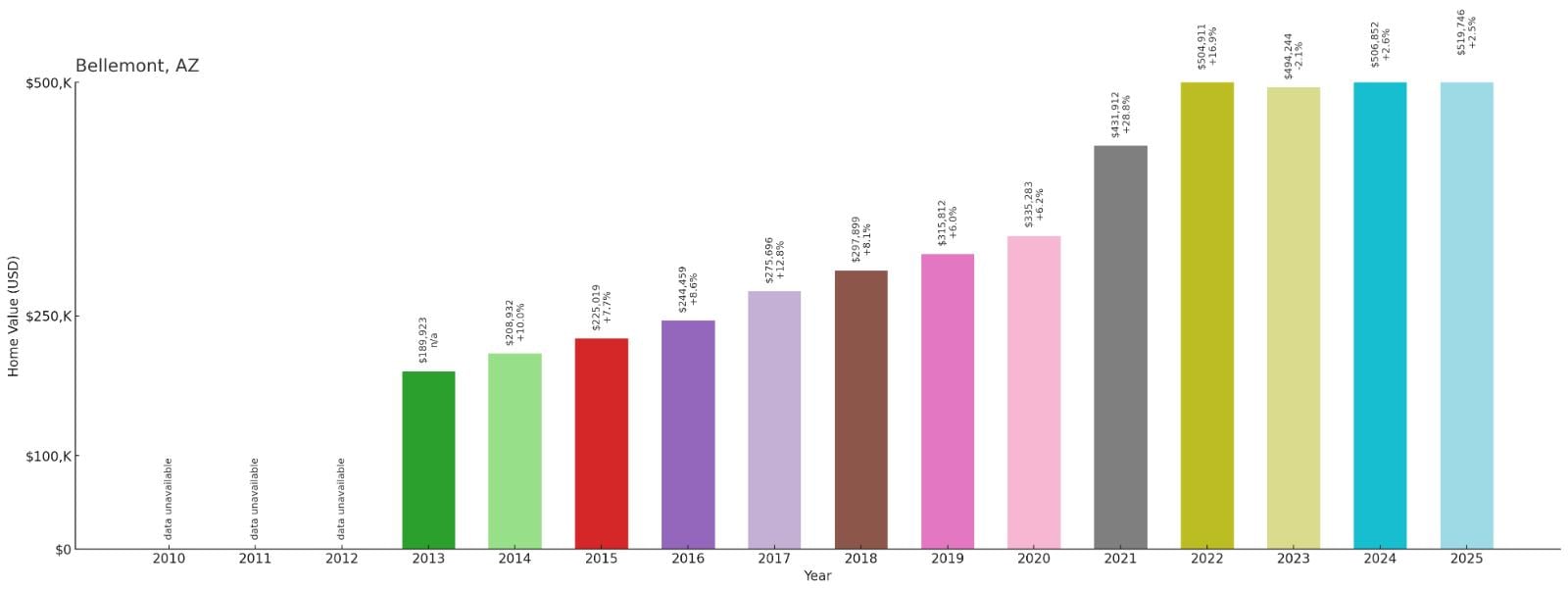
- 2010: N/A
- 2011: N/A
- 2012: N/A
- 2013: $189,923
- 2014: $208,932
- 2015: $225,019
- 2016: $244,459
- 2017: $275,696
- 2018: $297,899
- 2019: $315,812
- 2020: $335,283
- 2021: $431,912
- 2022: $504,911
- 2023: $494,244
- 2024: $506,852
- 2025: $519,746
Bellemont demonstrates consistent upward momentum with nearly a tripling of values since 2013. The community experienced its steepest appreciation during 2020-2022, when prices climbed from around $335,000 to over $500,000. Current median prices near $520,000 show continued strength in this mountain community market.
Why Bellemont?

Why are people willing to pay so much to live here? What’s special about it?
Bellemont offers mountain living with four-season appeal just west of Flagstaff on historic Route 66. Buyers value the cooler climate, pine forest setting, and access to outdoor recreation including skiing, hiking, and camping. The community provides a rural mountain lifestyle while remaining connected to Flagstaff’s amenities and employment opportunities.
Properties in Bellemont often feature larger lots with mature trees and mountain views that are increasingly rare in Arizona’s rapidly developing areas. The historic Route 66 location adds character and tourism appeal, while the elevation provides relief from desert heat that attracts both full-time residents and vacation home buyers.
How Bellemont Rose to Prominence
Bellemont’s history traces back to the late 1800s as a railroad stop and logging community along the Atlantic & Pacific Railroad route. The town served as an important water stop for steam locomotives and later became a service point along the famous Route 66 highway. Its name reportedly comes from Belle Fulton, wife of a local railroad official.
The community experienced renewed interest as Flagstaff grew and buyers sought more affordable mountain properties with rural character. Bellemont’s location along I-40 and historic Route 66 attracted buyers interested in the area’s transportation heritage, while its proximity to national forests and recreational areas appealed to outdoor enthusiasts seeking mountain retreats.
3 Interesting Tidbits
1. Route 66 Heritage – Bellemont sits along the historic Route 66, with vintage highway markers and classic Americana charm that adds nostalgic appeal for residents and visitors.
2. Railroad Legacy – The community originated as a Santa Fe Railway stop, and trains still pass through, connecting residents to Arizona’s transportation history.
3. Forest Access – Bellemont provides easy access to Coconino National Forest, offering residents unlimited hiking, camping, and outdoor recreation opportunities right from their doorstep.
28. Waddell – 200% Home Price Increase Since 2010
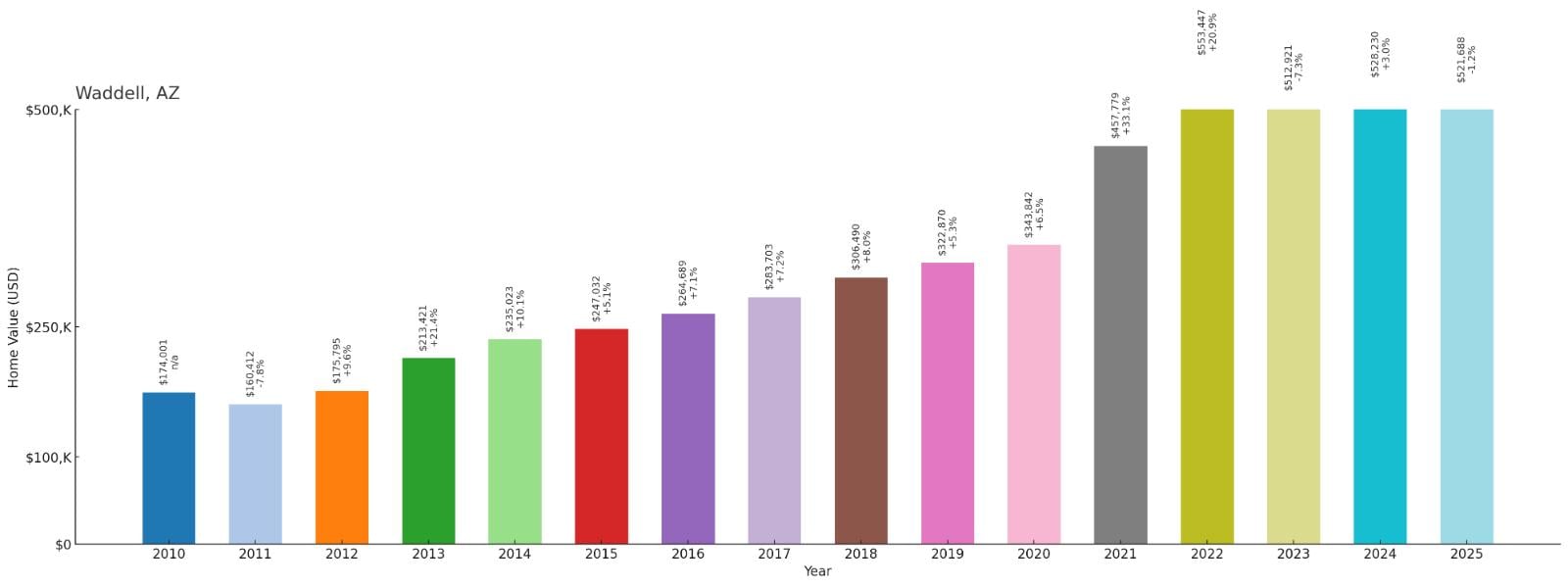
- 2010: $174,001
- 2011: $160,412
- 2012: $175,795
- 2013: $213,421
- 2014: $235,023
- 2015: $247,032
- 2016: $264,689
- 2017: $283,703
- 2018: $306,490
- 2019: $322,870
- 2020: $343,842
- 2021: $457,779
- 2022: $553,447
- 2023: $512,921
- 2024: $528,230
- 2025: $521,688
Waddell showcases exceptional growth with home values tripling from their 2010 baseline. The community weathered early market volatility before establishing steady appreciation through the 2010s. The most dramatic gains occurred during 2021-2022, pushing median values from around $344,000 to over $553,000 in just two years.
Why Waddell?
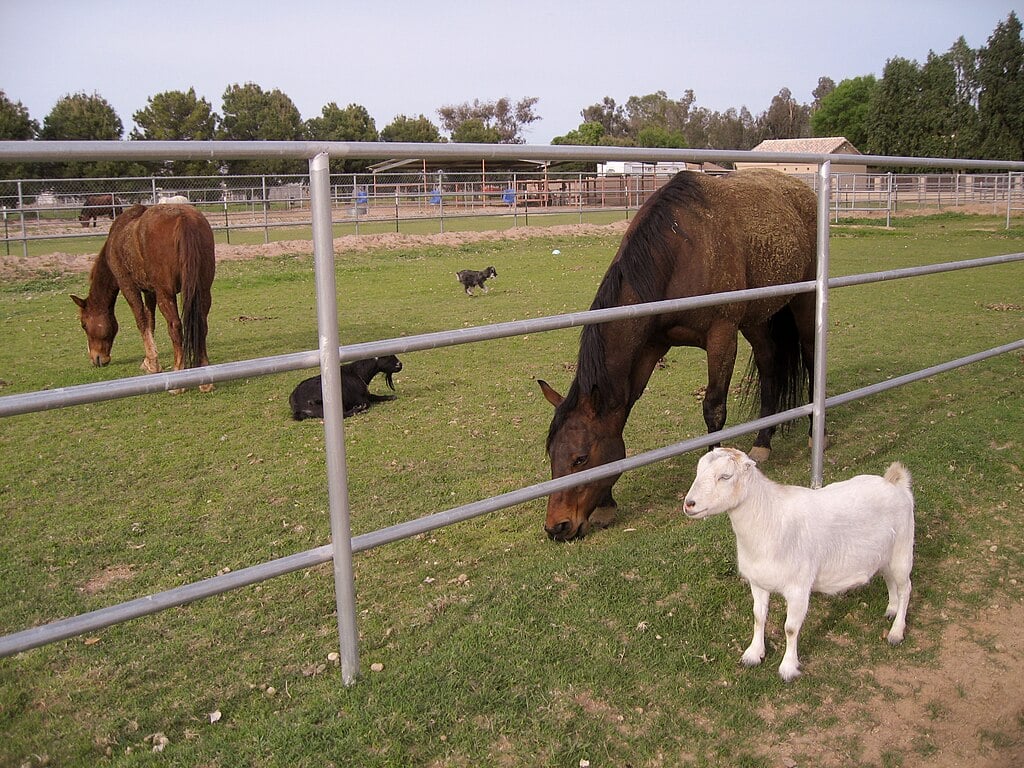
Why are people willing to pay so much to live here? What’s special about it?
Waddell attracts buyers seeking rural desert living on larger lots within the Phoenix metropolitan area. The community offers horse properties, custom homes, and a country lifestyle while maintaining access to suburban amenities and employment centers. Its location provides stunning desert and mountain views that create a premium living experience.
The area appeals to families wanting space for outdoor activities, horse ownership, and custom home building on multi-acre lots. Waddell’s rural zoning and agricultural heritage preserve a lifestyle that’s increasingly rare in the rapidly developing Phoenix area, justifying premium prices for buyers seeking authentic desert living.
How Waddell Rose to Prominence
Waddell originated as an agricultural community in the Sonoran Desert northwest of Phoenix, named after early settler William Waddell who established farming operations in the area during the late 1800s. The community remained largely agricultural through much of the 20th century, with cotton, alfalfa, and citrus crops dominating the landscape.
As Phoenix expanded northwestward, Waddell transitioned from farming to rural residential development while preserving its agricultural character. The area’s large lots, mountain views, and rural atmosphere attracted buyers seeking alternatives to dense suburban developments. This transformation accelerated during the 2000s as custom home builders and horse enthusiasts discovered the area’s potential.
3 Interesting Tidbits
1. Agricultural Heritage – Waddell preserves its farming roots with many properties still featuring citrus groves, horse pastures, and agricultural operations alongside residential development.
2. White Tank Mountains – The community sits near White Tank Mountain Regional Park, providing residents access to hiking trails, camping, and desert recreation areas.
3. Equestrian Culture – Waddell maintains strong horse community traditions with numerous boarding facilities, riding trails, and equestrian events that preserve the area’s ranch character.
27. Oracle – 139% Home Price Increase Since 2010
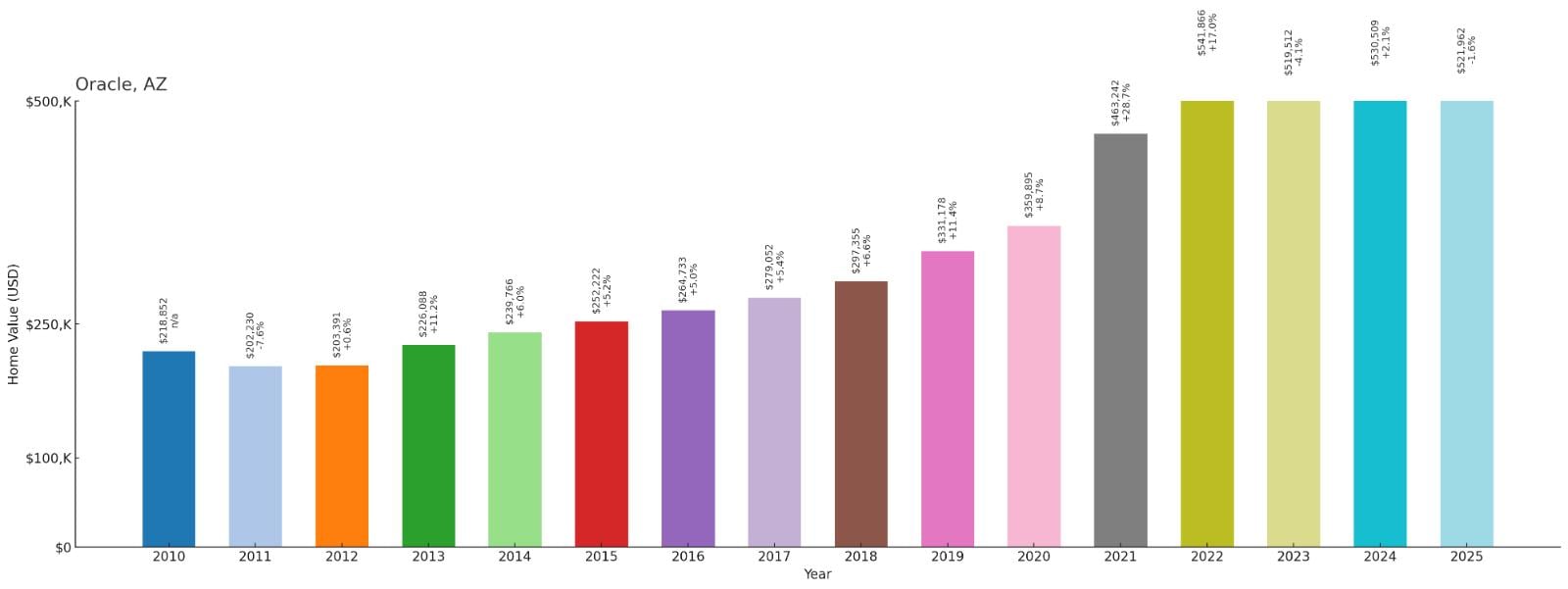
- 2010: $218,852
- 2011: $202,230
- 2012: $203,391
- 2013: $226,088
- 2014: $239,766
- 2015: $252,222
- 2016: $264,733
- 2017: $279,052
- 2018: $297,355
- 2019: $331,178
- 2020: $359,895
- 2021: $463,242
- 2022: $541,866
- 2023: $519,512
- 2024: $530,509
- 2025: $521,962
Oracle exhibits steady appreciation with values more than doubling since 2010. The community maintained consistent growth throughout the 2010s before accelerating dramatically during 2020-2022, when prices jumped from around $360,000 to over $540,000. Current median values near $522,000 reflect this mountain community’s growing appeal.
Why Oracle?
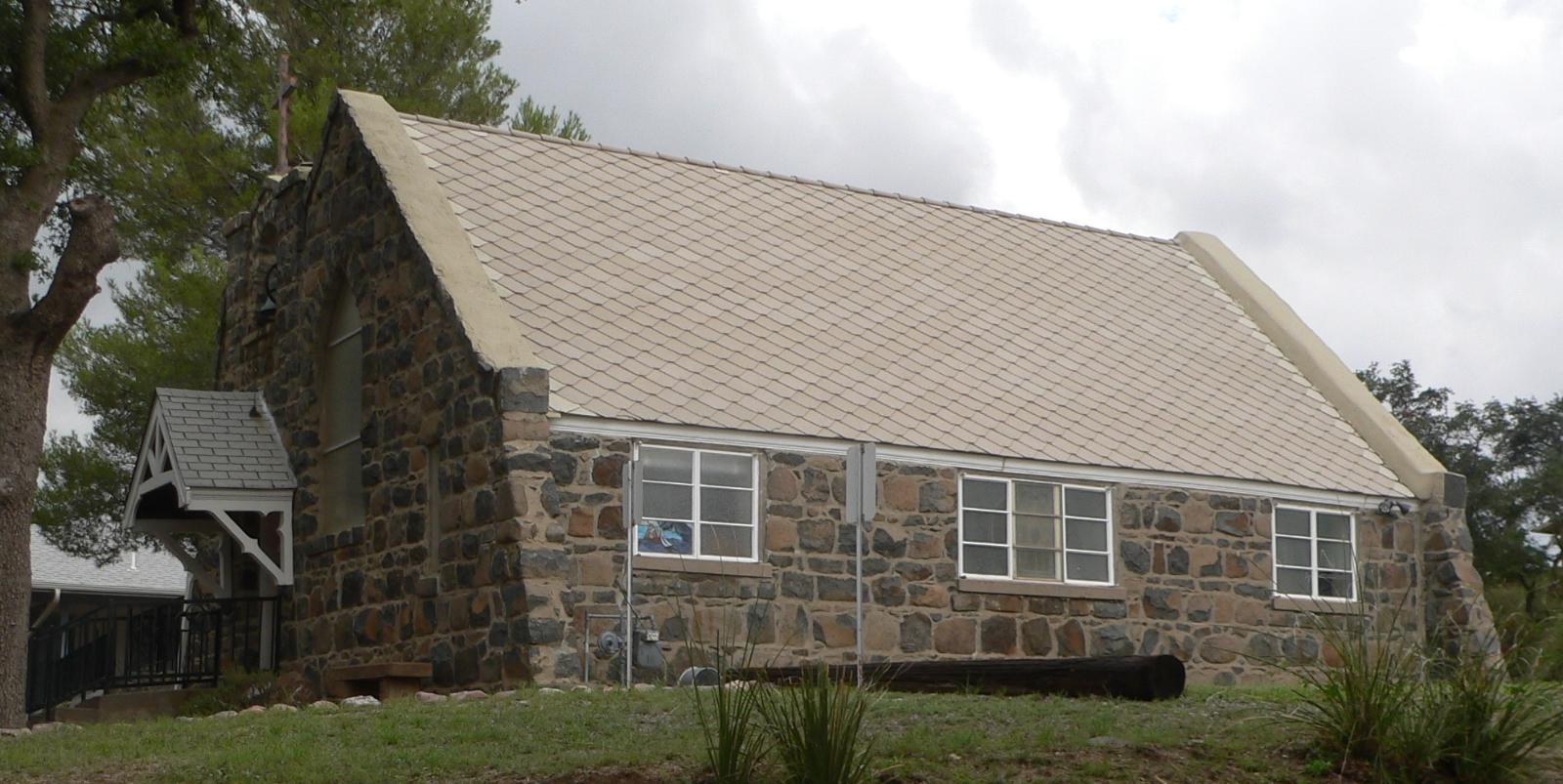
Why are people willing to pay so much to live here? What’s special about it?
Oracle offers high-desert mountain living with cooler temperatures and scenic beauty compared to Arizona’s low desert areas. Buyers are drawn to the community’s elevation, which provides relief from extreme summer heat, along with stunning views of the Santa Catalina Mountains and surrounding desert valleys. The area’s rural character and larger lots appeal to those seeking privacy and natural settings.
The community’s proximity to Tucson provides urban access while maintaining a small-town atmosphere and outdoor recreation opportunities. Oracle’s unique combination of mountain climate, desert scenery, and astronomical heritage creates distinctive appeal for buyers seeking something different from typical Arizona suburban development.
How Oracle Rose to Prominence
Oracle began as a mining camp in the 1880s, named after the USS Oracle ship where an early prospector had served. The town developed around gold and silver mining operations in the Santa Catalina Mountains, attracting miners and support businesses to the area. After mining declined, Oracle transitioned to cattle ranching and small-scale agriculture.
The community gained national attention in the 1990s as the site of Biosphere 2, the famous ecological research facility that brought scientific prestige to the area. Oracle’s elevation and clear skies also attracted astronomers and stargazers, adding to its reputation as a place where science and nature intersect. This unique heritage, combined with its mountain setting, has attracted buyers seeking distinctive Arizona living experiences.
3 Interesting Tidbits
1. Biosphere 2 – Oracle is home to the famous Biosphere 2 research facility, a unique sealed ecological system that has brought international scientific attention to the community.
2. Mining History – The town’s origins trace to 1880s gold and silver mining, with historic mine sites and mining equipment still visible throughout the surrounding mountains.
3. Dark Sky Haven – Oracle’s elevation and low light pollution make it popular with astronomers and stargazers who value the exceptional night sky viewing conditions.
26. Chandler – 158% Home Price Increase Since 2010
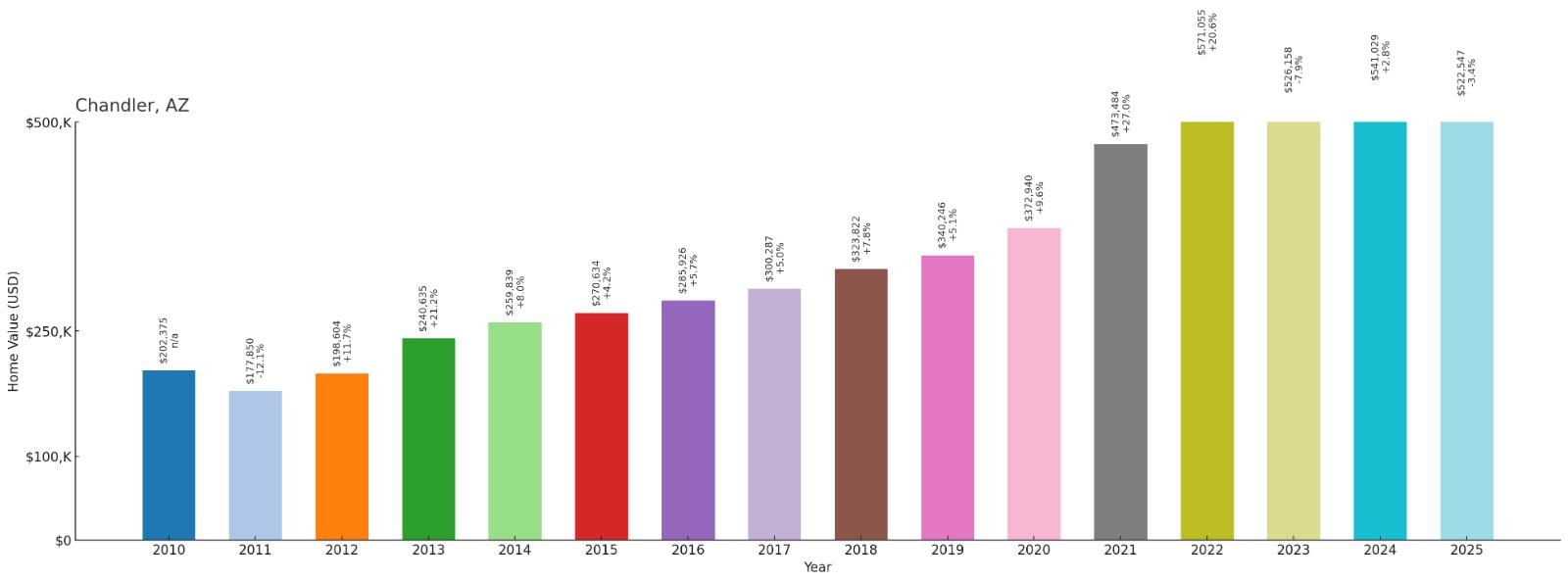
- 2010: $202,375
- 2011: $177,850
- 2012: $198,604
- 2013: $240,635
- 2014: $259,839
- 2015: $270,634
- 2016: $285,926
- 2017: $300,287
- 2018: $323,822
- 2019: $340,246
- 2020: $372,940
- 2021: $473,484
- 2022: $571,055
- 2023: $526,158
- 2024: $541,029
- 2025: $522,547
Chandler demonstrates remarkable appreciation with home values rising from around $202,000 to over $522,000. The city experienced steady growth through the 2010s before dramatic acceleration during 2020-2022, when prices jumped nearly 53% in two years. Current values reflect some cooling from peak levels but remain more than double their 2010 starting point.
Why Chandler?

Why are people willing to pay so much to live here? What’s special about it?
Chandler attracts families and professionals with its combination of excellent schools, master-planned communities, and thriving tech economy. The city has earned recognition as one of America’s safest cities while offering abundant parks, recreation facilities, and family-friendly amenities. Its strategic location in the Southeast Valley provides easy access to Phoenix Sky Harbor Airport and major employment centers.
The presence of major technology companies, including Intel’s largest manufacturing facility, creates high-paying jobs and economic stability that supports premium home values. Chandler’s well-planned development, modern infrastructure, and quality of life amenities justify higher prices for buyers seeking suburban excellence in the Phoenix area.
How Chandler Rose to Prominence
Chandler was founded in 1912 by Dr. Alexander John Chandler, who purchased land for agricultural development in the Salt River Valley. The community initially thrived as an agricultural center, particularly known for cotton production during the early to mid-20th century. The arrival of air conditioning and population growth in the Phoenix area transformed Chandler’s prospects.
The city’s transformation accelerated in the 1980s when technology companies began establishing operations in the area. Intel’s decision to build a major manufacturing facility in Chandler established the city as a technology hub, earning it the nickname “Silicon Desert.” This economic diversification, combined with master-planned development and strong municipal services, created the foundation for Chandler’s current status as one of Arizona’s most desirable suburban communities.
3 Interesting Tidbits
1. Silicon Desert Hub – Chandler hosts Intel’s largest manufacturing campus globally, plus operations from numerous other technology companies that drive the local economy.
2. Ostrich Festival – The city’s annual Ostrich Festival celebrates its agricultural heritage with rides, food, and entertainment, drawing visitors from across the Southwest.
3. Master-Planned Excellence – Chandler features numerous award-winning master-planned communities with golf courses, parks, and amenities that set standards for suburban development.
25. Litchfield Park – 194% Home Price Increase Since 2010
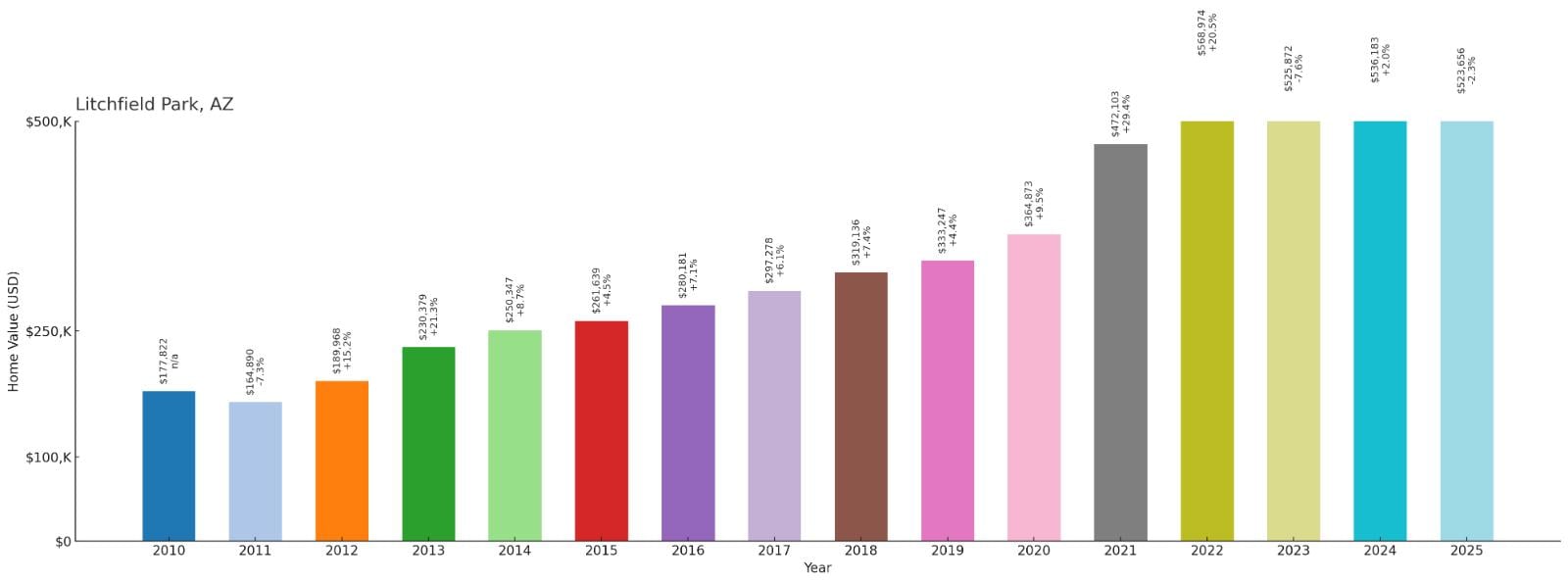
- 2010: $177,822
- 2011: $164,890
- 2012: $189,968
- 2013: $230,379
- 2014: $250,347
- 2015: $261,639
- 2016: $280,181
- 2017: $297,278
- 2018: $319,136
- 2019: $333,247
- 2020: $364,873
- 2021: $472,103
- 2022: $568,974
- 2023: $525,872
- 2024: $536,183
- 2025: $523,656
Litchfield Park shows extraordinary growth with home values nearly tripling from their 2010 baseline. After recovering from early market volatility, the community established strong upward momentum through the 2010s. The most dramatic appreciation occurred during 2020-2022, when median prices surged from around $365,000 to nearly $569,000.
Why Litchfield Park?

Why are people willing to pay so much to live here? What’s special about it?
Litchfield Park offers historic charm combined with modern amenities in one of Arizona’s first master-planned communities. Buyers value the tree-lined streets, distinctive architecture, and small-town atmosphere within the Phoenix metropolitan area. The community’s golf course, parks, and walkable downtown create a unique suburban experience that preserves its planned community heritage.
The city’s excellent schools, low crime rates, and family-friendly environment attract buyers willing to pay premium prices for quality of life. Litchfield Park’s historic significance and architectural character set it apart from newer developments, while its location provides convenient access to Phoenix employment centers and amenities.
How Litchfield Park Rose to Prominence
Litchfield Park was created in 1916 by Paul Litchfield, president of Goodyear Tire & Rubber Company, as a planned community to support cotton production for tire manufacturing. The company town featured distinctive Spanish Colonial Revival architecture and innovative urban planning concepts that were ahead of their time. Workers lived in company housing while cultivating cotton for Goodyear’s tire production.
After World War II, Goodyear sold the residential areas to private ownership, and Litchfield Park incorporated as an independent city in 1987. The community preserved its historic character and planned development approach while adapting to suburban growth in the Phoenix area. This unique heritage, combined with ongoing preservation efforts, has created a distinctive community that commands premium values in the regional market.
3 Interesting Tidbits
1. Goodyear Heritage – Litchfield Park was founded by Goodyear Tire Company as a planned community to support cotton production for tire manufacturing, creating unique architectural and historical character.
2. Wigwam Resort – The historic Wigwam Resort, opened in 1929, remains a luxury destination that adds prestige and tourism appeal to the community.
3. Tree-Lined Streets – The community features mature trees and landscaping from its original planning in the 1910s, creating an unusually green and shaded environment in the desert.
24. Cornville – 168% Home Price Increase Since 2010
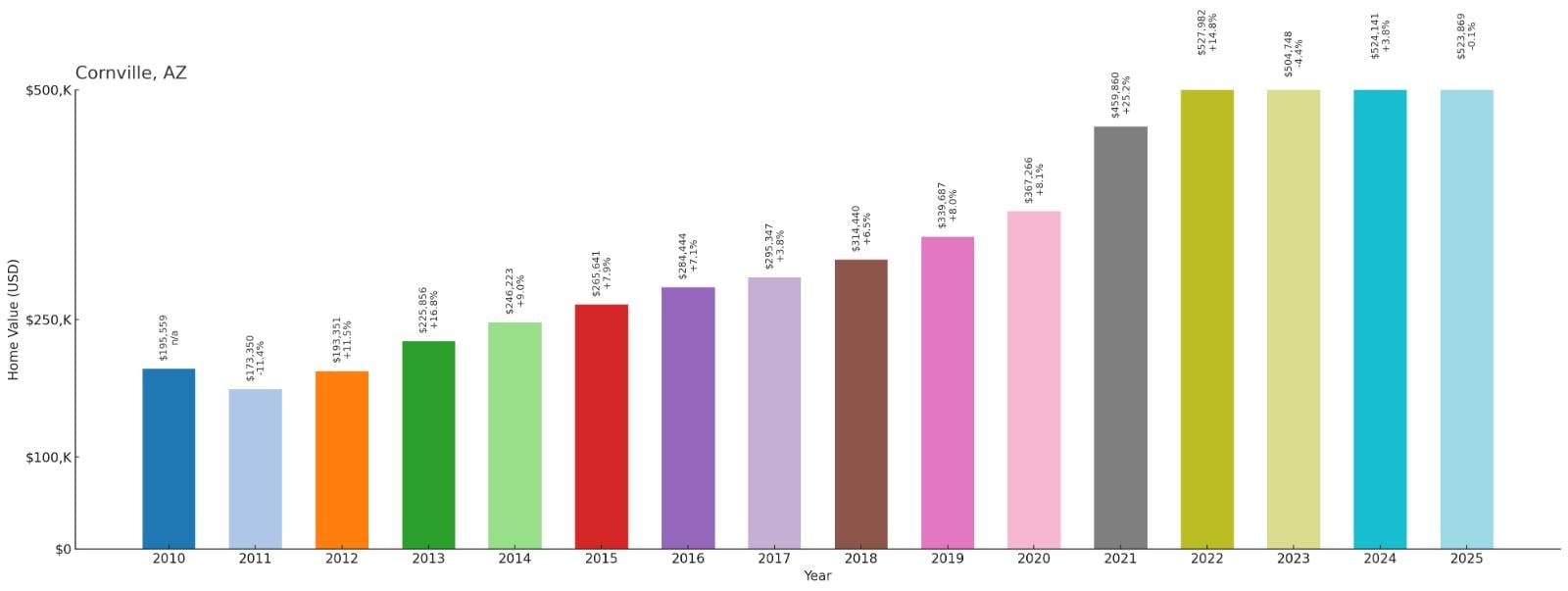
- 2010: $195,559
- 2011: $173,350
- 2012: $193,351
- 2013: $225,856
- 2014: $246,223
- 2015: $265,641
- 2016: $284,444
- 2017: $295,347
- 2018: $314,440
- 2019: $339,687
- 2020: $367,266
- 2021: $459,860
- 2022: $527,982
- 2023: $504,748
- 2024: $524,141
- 2025: $523,869
Cornville exhibits strong appreciation with values more than doubling since 2010. The community maintained steady growth throughout the 2010s before experiencing significant acceleration during 2020-2022, when prices jumped from around $367,000 to nearly $528,000. Current median values near $524,000 demonstrate the sustained appeal of this Verde Valley location.
Why Cornville?

Why are people willing to pay so much to live here? What’s special about it?
Cornville attracts buyers seeking rural living in Arizona’s scenic Verde Valley, located between Sedona and Flagstaff. The community offers agricultural properties, horse ranches, and stunning red rock views that create a premium lifestyle experience. Buyers value the combination of rural tranquility and proximity to Sedona’s amenities and natural attractions.
The area’s elevation provides cooler temperatures than low desert areas, while the agricultural zoning allows for horses, farming, and rural pursuits increasingly rare in Arizona. Cornville’s position in the Verde Valley corridor benefits from tourism and growth pressure from nearby Sedona, supporting higher property values for this rural community.
How Cornville Rose to Prominence
Cornville was established in the 1880s as an agricultural settlement in the Verde Valley, named for the corn crops that early farmers successfully cultivated in the area’s fertile soil. The community developed around farming and ranching operations that took advantage of the Verde River’s water resources and the valley’s agricultural potential.
The area remained primarily agricultural through much of the 20th century until proximity to Sedona and Flagstaff began attracting buyers seeking rural properties near major tourist destinations. Cornville’s agricultural heritage, scenic setting, and large lots appealed to horse enthusiasts, artists, and others seeking alternatives to urban development while remaining connected to the region’s growing amenities and attractions.
3 Interesting Tidbits
1. Verde Valley Agriculture – Cornville preserves Verde Valley’s agricultural heritage with active farms, ranches, and vineyards that maintain the area’s rural character.
2. Red Rock Views – Many properties feature spectacular views of Sedona’s famous red rock formations and the surrounding Coconino National Forest landscapes.
3. Equestrian Community – The area maintains strong horse culture with numerous stables, riding trails, and equestrian facilities that attract horse enthusiasts from across Arizona.
23. Wickenburg – 142% Home Price Increase Since 2010
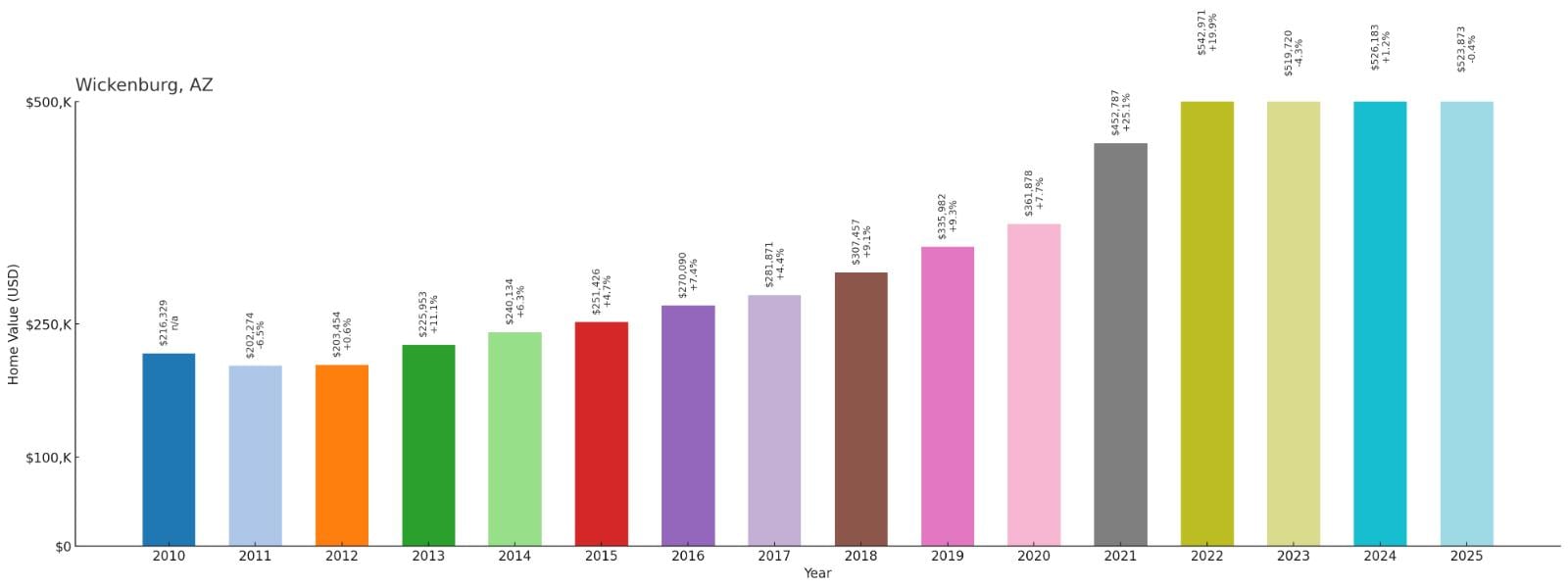
- 2010: $216,329
- 2011: $202,274
- 2012: $203,454
- 2013: $225,953
- 2014: $240,134
- 2015: $251,426
- 2016: $270,090
- 2017: $281,871
- 2018: $307,457
- 2019: $335,982
- 2020: $361,878
- 2021: $452,787
- 2022: $542,971
- 2023: $519,720
- 2024: $526,183
- 2025: $523,873
Wickenburg demonstrates solid appreciation with home values more than doubling from their 2010 starting point. The community showed steady growth through the 2010s before experiencing dramatic acceleration during 2020-2022, when prices surged from around $362,000 to over $543,000. Current values near $524,000 reflect the sustained appeal of this historic desert town.
Why Wickenburg?
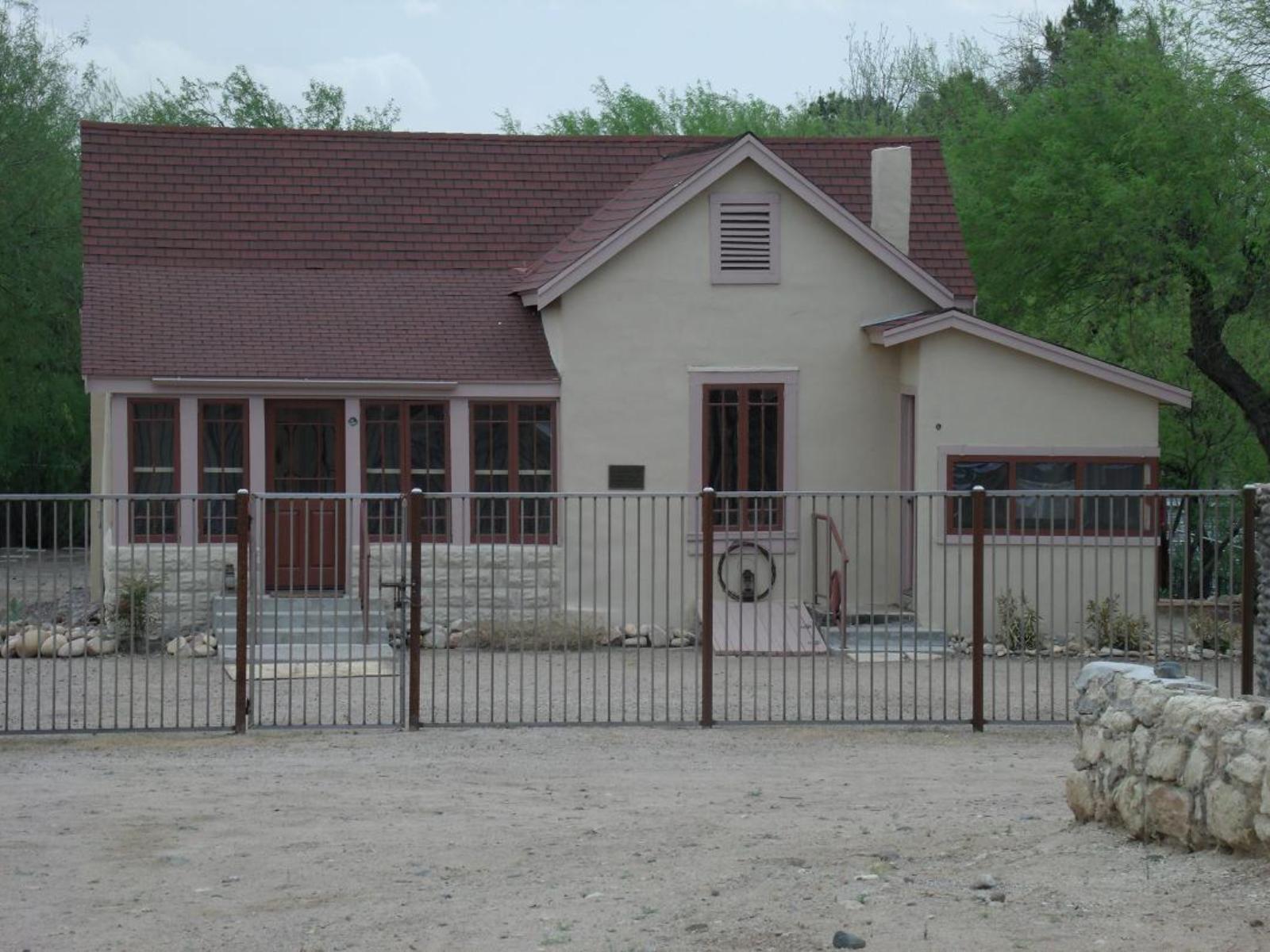
Why are people willing to pay so much to live here? What’s special about it?
Wickenburg appeals to buyers seeking authentic Old West character combined with modern amenities in Arizona’s Sonoran Desert. The town offers historic charm, guest ranches, and desert lifestyle opportunities that attract both full-time residents and seasonal visitors. Its location northwest of Phoenix provides small-town atmosphere while maintaining access to metropolitan amenities.
The community’s Western heritage, preserved through museums, events, and architecture, creates unique character that sets it apart from typical suburban development. Wickenburg’s combination of history, outdoor recreation, and desert beauty justifies premium prices for buyers seeking distinctive Arizona living experiences.
How Wickenburg Rose to Prominence
Wickenburg was founded in 1863 by Henry Wickenburg after he discovered gold at the Vulture Mine, which became one of Arizona’s most productive gold mines. The town developed as a supply center for miners and later evolved into a cattle ranching and agricultural community. Its location along the Hassayampa River provided water resources that supported early settlement.
The town gained fame as a dude ranch destination in the early to mid-20th century, hosting guests from across the country who came to experience authentic Western lifestyle. This tourism heritage, combined with its preserved historic character and desert setting, has attracted buyers seeking alternatives to urban development while enjoying the area’s Western ambiance and outdoor recreation opportunities.
3 Interesting Tidbits
1. Gold Rush Heritage – Wickenburg originated as a gold mining town in 1863, with the historic Vulture Mine producing millions of dollars in gold and establishing the area’s frontier character.
2. Dude Ranch Capital – The town became known as the “Dude Ranch Capital of the World” during the mid-20th century, hosting guests at numerous Western-themed resorts.
3. Desert Museum – The Desert Caballeros Western Museum preserves and celebrates the area’s mining, ranching, and artistic heritage, attracting visitors interested in authentic Western culture.
22. Elgin – 93% Home Price Increase Since 2010

- 2010: $279,638
- 2011: $254,952
- 2012: $270,012
- 2013: $287,339
- 2014: $290,500
- 2015: $305,449
- 2016: $318,439
- 2017: $332,321
- 2018: $322,527
- 2019: $352,429
- 2020: $378,241
- 2021: $467,233
- 2022: $525,398
- 2023: $515,618
- 2024: $547,563
- 2025: $540,640
Elgin shows steady appreciation with values nearly doubling from their already elevated 2010 baseline of around $280,000. The community maintained consistent growth through the 2010s before experiencing significant acceleration during 2020-2022, when prices jumped from around $378,000 to over $525,000. Current median values near $541,000 reflect this wine country community’s growing appeal.
Why Elgin?
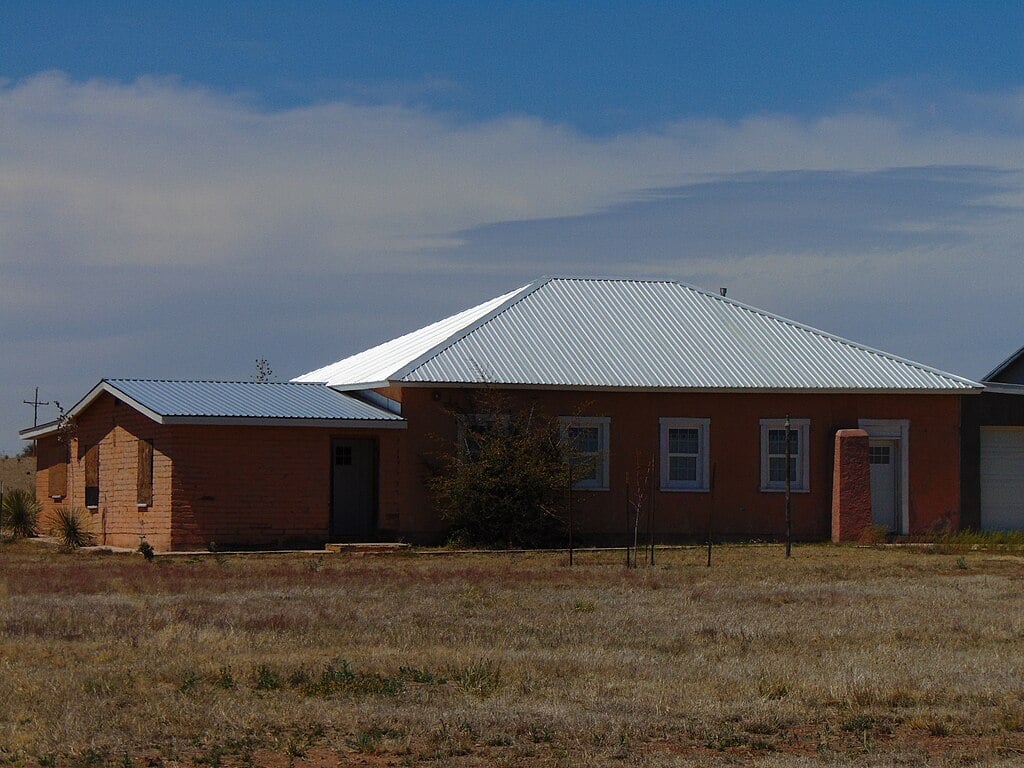
Why are people willing to pay so much to live here? What’s special about it?
Elgin attracts buyers seeking rural wine country living in Arizona’s scenic Sonoita-Elgin region southeast of Tucson. The community offers vineyard properties, equestrian facilities, and stunning grassland views that create a unique Arizona lifestyle experience. Buyers value the combination of agricultural heritage, wine tourism, and cooler high-desert climate compared to low desert areas.
The area’s elevation provides relief from extreme heat while supporting viticulture and ranching operations that preserve rural character. Elgin’s position in Arizona’s premier wine region adds prestige and tourism appeal, while large lots and agricultural zoning attract buyers seeking privacy and space for horses or farming pursuits.
How Elgin Rose to Prominence
Elgin was established in the 1880s as a railroad stop and agricultural community in the high grasslands southeast of Tucson. The area’s elevation and climate proved suitable for cattle ranching and later for grape cultivation, as settlers discovered the region’s potential for agriculture. The community remained primarily ranching-focused through much of the 20th century.
The modern wine industry began developing in the 1970s and 1980s when pioneering vintners recognized the area’s potential for grape cultivation. This agricultural diversification, combined with the region’s scenic beauty and proximity to Tucson, attracted buyers seeking rural properties with unique character. Elgin’s wine country designation has enhanced property values and attracted buyers interested in agritourism and lifestyle farming.
3 Interesting Tidbits
1. Wine Country Hub – Elgin sits in the heart of Arizona’s Sonoita-Elgin wine region, with numerous vineyards and tasting rooms that add tourism appeal and agricultural character.
2. Grassland Setting – The community features rare Arizona grasslands rather than desert scenery, creating a distinctive landscape that resembles parts of Montana or Wyoming.
3. Ranching Heritage – Many properties maintain active cattle operations and equestrian facilities that preserve the area’s agricultural traditions and Western character.
21. Pinetop – 135% Home Price Increase Since 2010
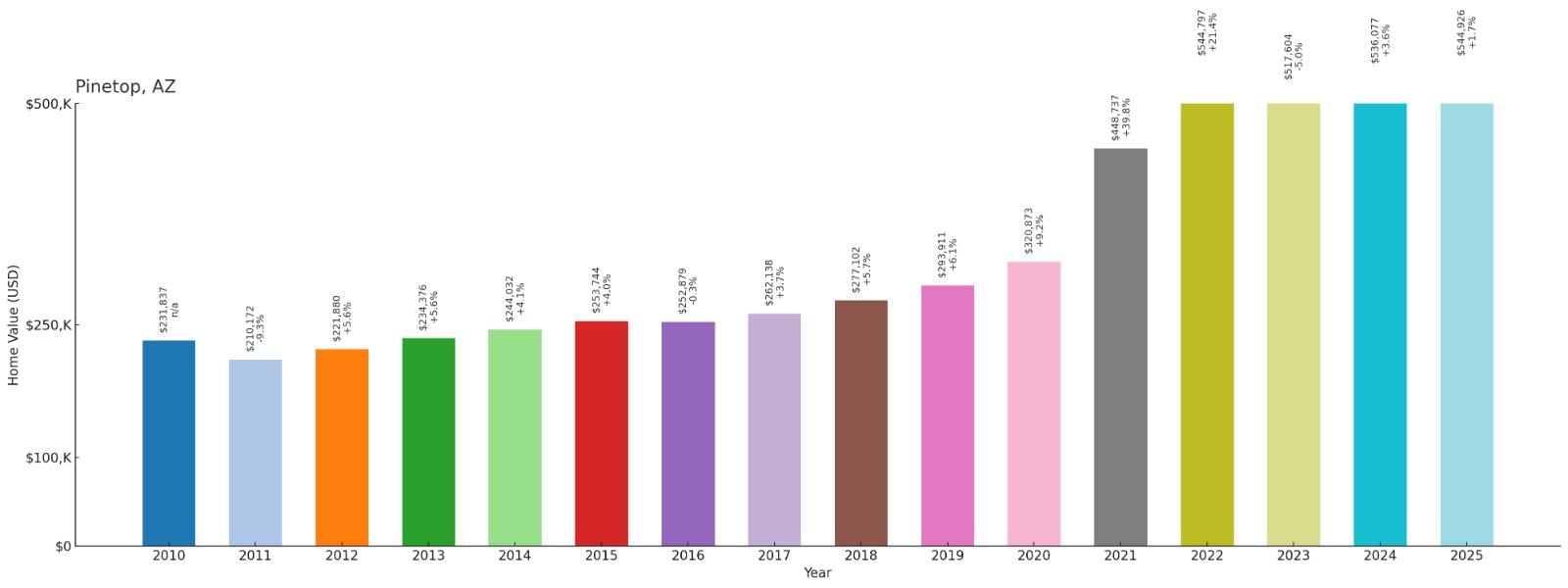
- 2010: $231,837
- 2011: $210,172
- 2012: $221,880
- 2013: $234,376
- 2014: $244,032
- 2015: $253,744
- 2016: $252,879
- 2017: $262,138
- 2018: $277,102
- 2019: $293,911
- 2020: $320,873
- 2021: $448,737
- 2022: $544,797
- 2023: $517,604
- 2024: $536,077
- 2025: $544,926
Pinetop demonstrates impressive growth with home values more than doubling since 2010. The mountain community maintained modest appreciation through the 2010s before experiencing dramatic acceleration during 2020-2022, when prices surged from around $321,000 to nearly $545,000. Current values near $545,000 show continued strength in this White Mountains retreat.
Why Pinetop?

Why are people willing to pay so much to live here? What’s special about it?
Pinetop offers mountain living with four-season appeal in Arizona’s White Mountains, providing relief from desert heat with pine forests, lakes, and outdoor recreation. Buyers value the cooler climate, scenic beauty, and recreational opportunities including skiing, fishing, and hiking. The community attracts both full-time residents and vacation home buyers seeking mountain retreats.
The area’s elevation and natural setting create a unique Arizona experience that contrasts sharply with desert environments. Pinetop’s combination of mountain lifestyle, outdoor activities, and small-town character justifies premium prices for buyers seeking alternatives to urban development while enjoying four-season mountain living.
How Pinetop Rose to Prominence
Pinetop began as a logging and ranching community in the late 1800s, taking advantage of the White Mountains’ timber resources and high elevation grazing land. The area’s cool climate and abundant water made it attractive for both lumber operations and cattle ranching. Early settlers appreciated the relief from Arizona’s desert heat.
The community evolved into a recreation destination in the mid-20th century as improved roads made the area accessible to urban residents seeking mountain retreats. Pinetop’s development as a resort and vacation home destination accelerated tourism growth, while its natural amenities attracted retirees and others seeking four-season mountain living within Arizona.
3 Interesting Tidbits
1. White Mountains Gateway – Pinetop serves as a gateway to the White Mountain Apache Reservation and numerous outdoor recreation areas including lakes, hiking trails, and ski areas.
2. Four-Season Climate – The community enjoys a unique four-season mountain climate with snow in winter and comfortable summers, rare in Arizona’s predominantly desert environment.
3. Logging Heritage – Historic sawmills and timber operations shaped the community’s early development, with remnants of the logging industry still visible throughout the area.
20. Forest Lakes – 127% Home Price Increase Since 2010
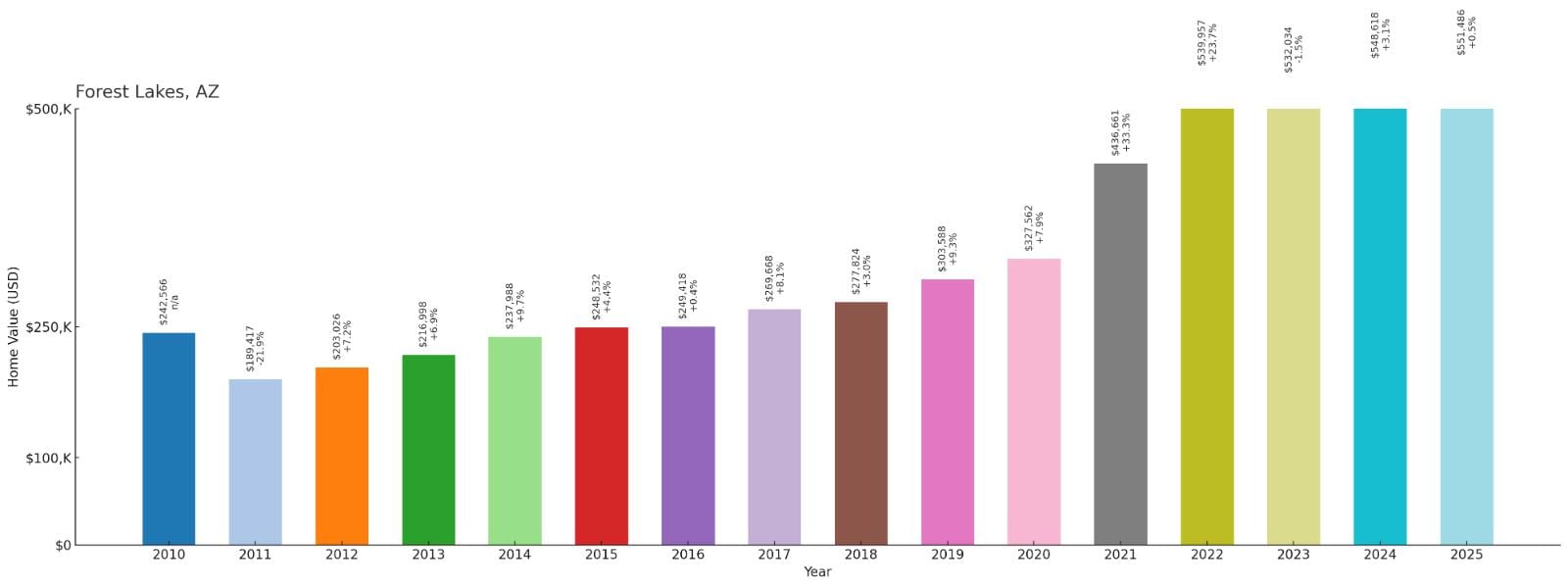
- 2010: $242,566
- 2011: $189,417
- 2012: $203,026
- 2013: $216,998
- 2014: $237,988
- 2015: $248,532
- 2016: $249,418
- 2017: $269,668
- 2018: $277,824
- 2019: $303,588
- 2020: $327,562
- 2021: $436,661
- 2022: $539,957
- 2023: $532,034
- 2024: $548,618
- 2025: $551,486
Forest Lakes shows strong appreciation with values more than doubling since 2010, despite early volatility that saw prices dip in 2011-2012. The community established steady growth through the 2010s before dramatic acceleration during 2020-2022, when prices jumped from around $328,000 to nearly $540,000. Current values above $551,000 demonstrate continued strength.
Why Forest Lakes?

Why are people willing to pay so much to live here? What’s special about it?
Forest Lakes attracts buyers seeking mountain cabin living along Arizona’s Mogollon Rim, offering pine forests, lakes, and recreational opportunities in a secluded setting. The community provides relief from desert heat with its elevation and natural amenities including fishing, hiking, and wildlife viewing. Buyers value the combination of mountain lifestyle and proximity to recreational activities.
The area’s small-scale development and preserved natural setting create an exclusive mountain retreat atmosphere that appeals to vacation home buyers and those seeking alternatives to urban living. Forest Lakes’ unique combination of forested setting, lake access, and mountain recreation justifies premium prices for this distinctive Arizona mountain community.
How Forest Lakes Rose to Prominence
Forest Lakes developed as a recreational community along the Mogollon Rim in central Arizona, taking advantage of the area’s natural lakes, forests, and cooler mountain climate. The community emerged in the mid-20th century as improved access roads made the remote area available for vacation home development and recreational use.
The area’s appeal grew as urban residents sought mountain retreats with lake access and forest recreation opportunities. Forest Lakes’ development remained small-scale and environmentally sensitive, preserving the natural character that attracts buyers seeking authentic mountain experiences within Arizona’s diverse landscape.
3 Interesting Tidbits
1. Mogollon Rim Setting – Forest Lakes sits along the scenic Mogollon Rim, a dramatic geological escarpment that provides stunning views and diverse ecosystems.
2. Natural Lakes – The community features several natural lakes that provide fishing, boating, and recreational opportunities rare in Arizona’s predominantly arid environment.
3. Wildlife Haven – The forested setting supports diverse wildlife including elk, deer, and numerous bird species that create exceptional viewing opportunities for residents.
19. Greer – 9% Home Price Increase Since 2023
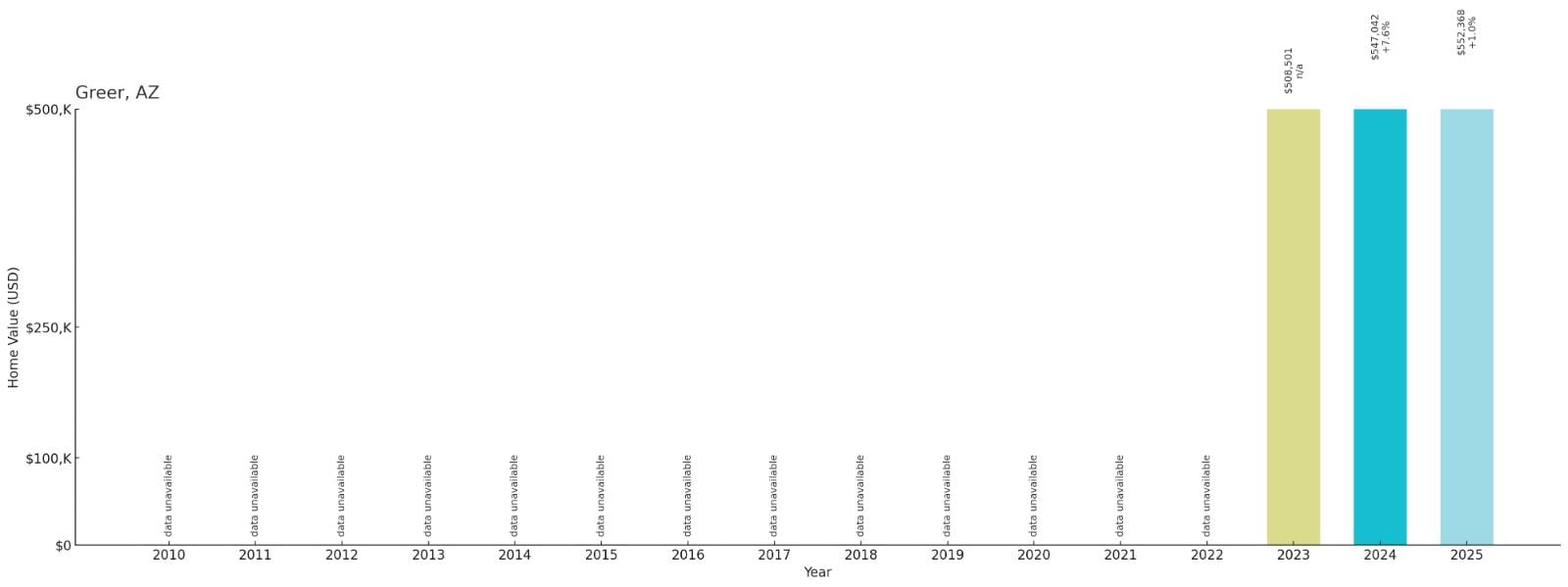
- 2010: N/A
- 2011: N/A
- 2012: N/A
- 2013: N/A
- 2014: N/A
- 2015: N/A
- 2016: N/A
- 2017: N/A
- 2018: N/A
- 2019: N/A
- 2020: N/A
- 2021: N/A
- 2022: N/A
- 2023: $508,501
- 2024: $547,042
- 2025: $552,368
Greer shows steady appreciation in its limited data period, with values rising from around $509,000 in 2023 to over $552,000 in 2025. The 9% increase reflects continued demand for this exclusive White Mountains community. Current median values above $552,000 position Greer among Arizona’s premium mountain retreat destinations.
Why Greer?
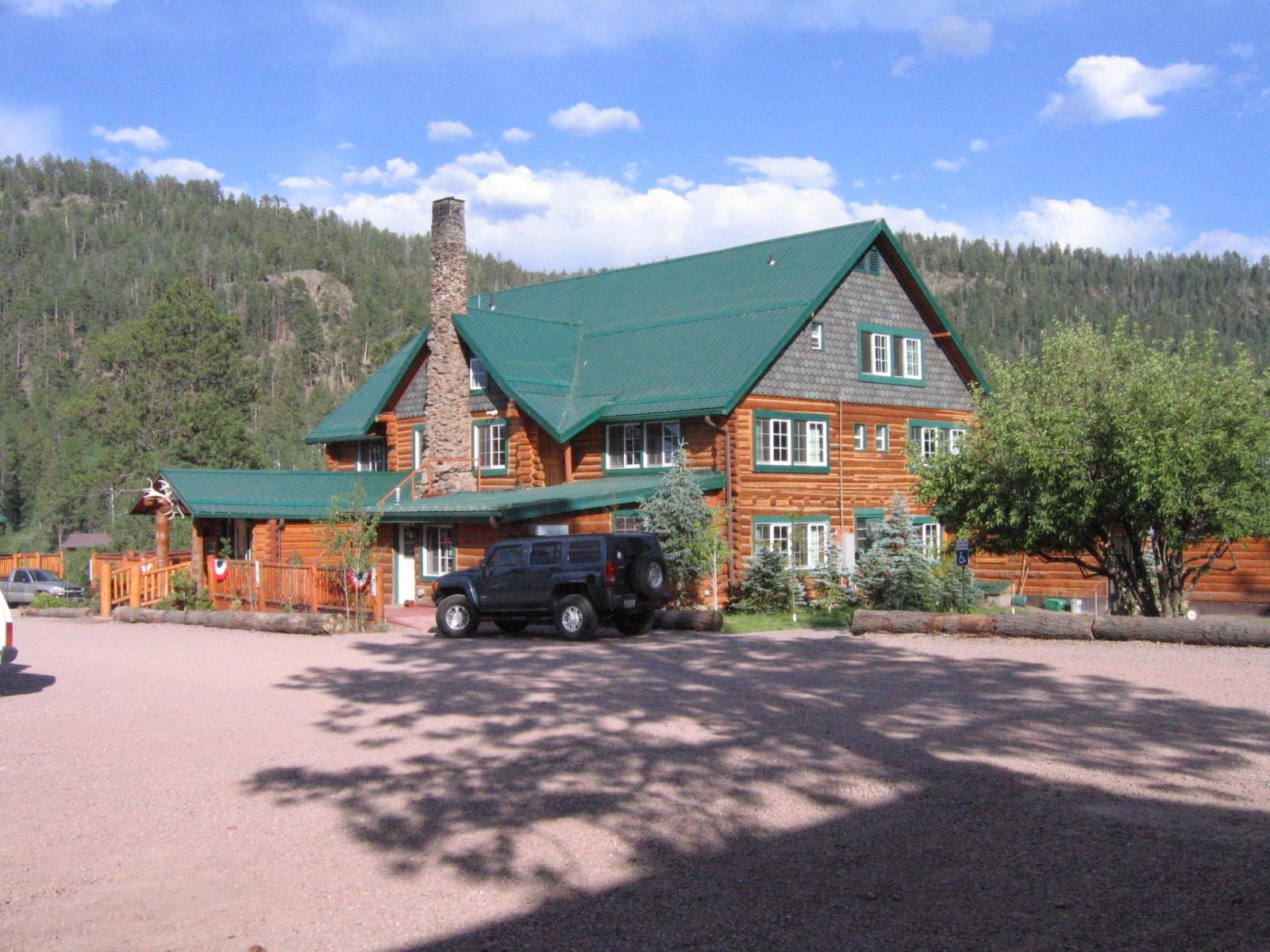
Why are people willing to pay so much to live here? What’s special about it?
Greer offers exclusive mountain living in Arizona’s White Mountains with alpine scenery, trout streams, and four-season recreation. The tiny community provides an intimate mountain village atmosphere with cabins, lodges, and outdoor activities that create a unique Arizona experience. Buyers value the area’s pristine natural setting and recreational opportunities including skiing, fishing, and hiking.
The community’s small size and remote location create exclusivity that appeals to buyers seeking privacy and authentic mountain living. Greer’s combination of alpine environment, recreational amenities, and preserved natural character justifies premium prices for this distinctive mountain retreat.
How Greer Rose to Prominence
Greer was established in the 1870s by Mormon pioneers who appreciated the area’s mountain meadows, streams, and cooler climate for summer settlements and livestock grazing. The community remained small and isolated, connected to the outside world primarily through pack trails and later primitive roads through the White Mountains.
The area developed as a recreation destination in the mid-20th century as improved access attracted visitors seeking mountain experiences within Arizona. Greer’s small scale, natural beauty, and recreational opportunities have maintained its character as an exclusive mountain retreat that attracts buyers seeking authentic alpine experiences.
3 Interesting Tidbits
1. Alpine Environment – Greer sits at over 8,500 feet elevation, creating an alpine environment with aspen groves, mountain meadows, and snow-covered winters unusual in Arizona.
2. Trout Fishing – The Little Colorado River and nearby streams provide excellent trout fishing opportunities that attract anglers from across the Southwest.
3. Historic Lodge – The community features historic lodges and cabins that preserve its early settlement character while serving modern mountain recreation needs.
18. Anthem – 182% Home Price Increase Since 2010

- 2010: $201,290
- 2011: $191,964
- 2012: $223,862
- 2013: $265,591
- 2014: $283,698
- 2015: $288,230
- 2016: $300,216
- 2017: $311,831
- 2018: $330,705
- 2019: $343,713
- 2020: $373,536
- 2021: $502,238
- 2022: $615,022
- 2023: $561,955
- 2024: $582,055
- 2025: $567,111
Anthem demonstrates exceptional growth with home values nearly tripling from their 2010 starting point. The master-planned community showed steady appreciation through the 2010s before experiencing dramatic acceleration during 2020-2022, when prices surged from around $374,000 to over $615,000. Current values near $567,000 reflect some market adjustment but remain well above historic levels.
Why Anthem?
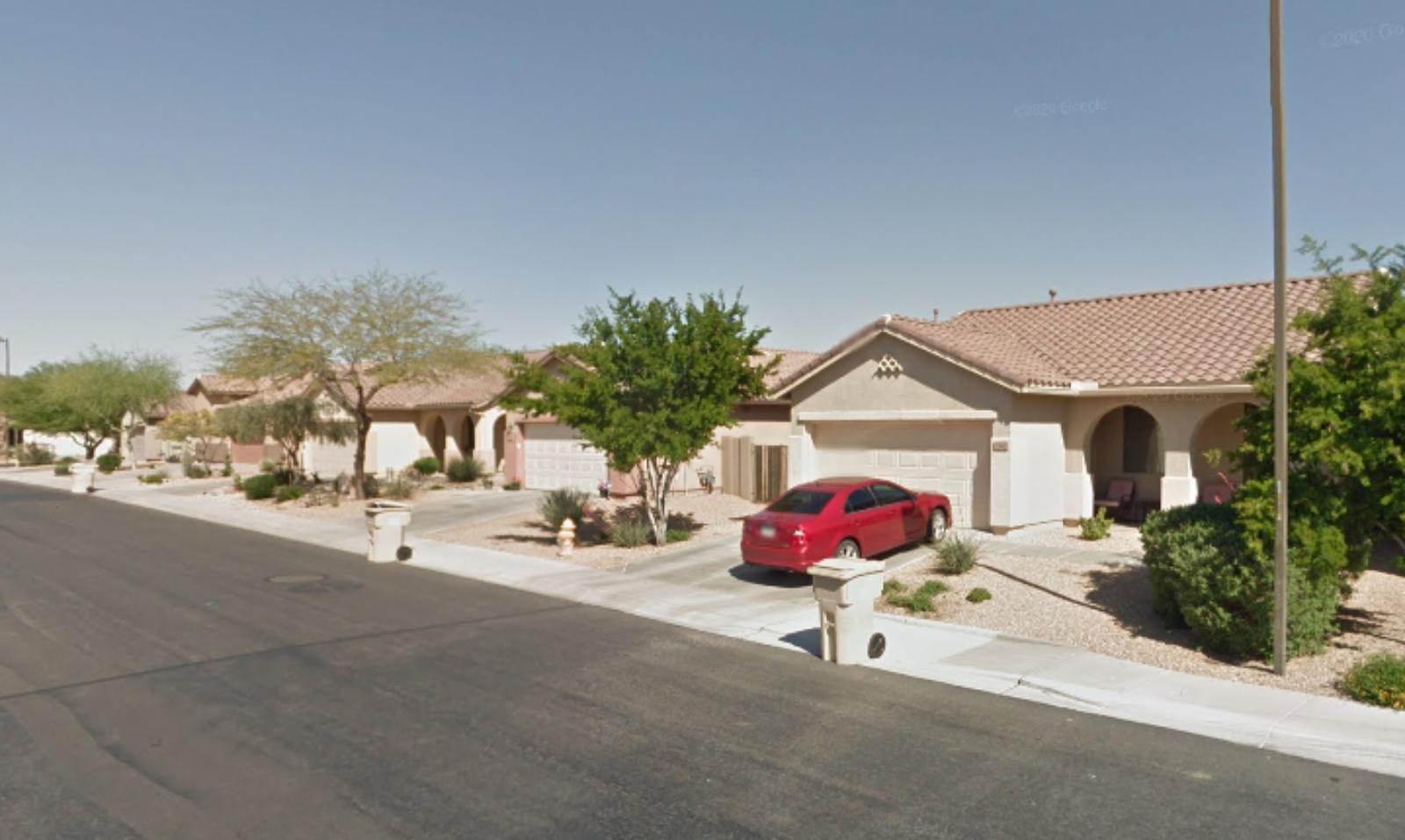
Why are people willing to pay so much to live here? What’s special about it?
Anthem attracts families and professionals with its master-planned community design featuring golf courses, parks, and resort-style amenities. The community offers newer homes, excellent schools, and recreational facilities that create a premium suburban lifestyle. Buyers value the planned development’s attention to quality, open space preservation, and family-oriented amenities.
The community’s location in the North Valley provides desert views and hiking access while maintaining convenience to Phoenix employment centers. Anthem’s combination of master-planned excellence, recreational amenities, and newer housing stock justifies premium prices for buyers seeking modern suburban living in the Phoenix area.
How Anthem Rose to Prominence
Anthem was developed beginning in 1999 as a master-planned community by Del Webb Corporation in the foothills north of Phoenix. The development was designed to create a complete community with residential neighborhoods, commercial areas, schools, and recreational amenities integrated into the natural desert landscape.
The community’s design emphasized preservation of desert washes and mountain views while providing modern amenities and infrastructure. Anthem’s master-planned approach, combined with its scenic location and quality construction, quickly established it as one of the Phoenix area’s premier suburban communities, attracting families and professionals seeking modern desert living.
3 Interesting Tidbits
1. Master-Planned Design – Anthem was carefully planned to preserve natural desert washes and mountain views while integrating residential, commercial, and recreational areas.
2. Anthem Veterans Memorial – The community features a unique veterans memorial that aligns with the sun on Veterans Day to create a stunning tribute to military service.
3. Desert Foothills – The community sits in scenic desert foothills with hiking trails, preserved open space, and mountain views that enhance the living experience.
17. Gilbert – 181% Home Price Increase Since 2010
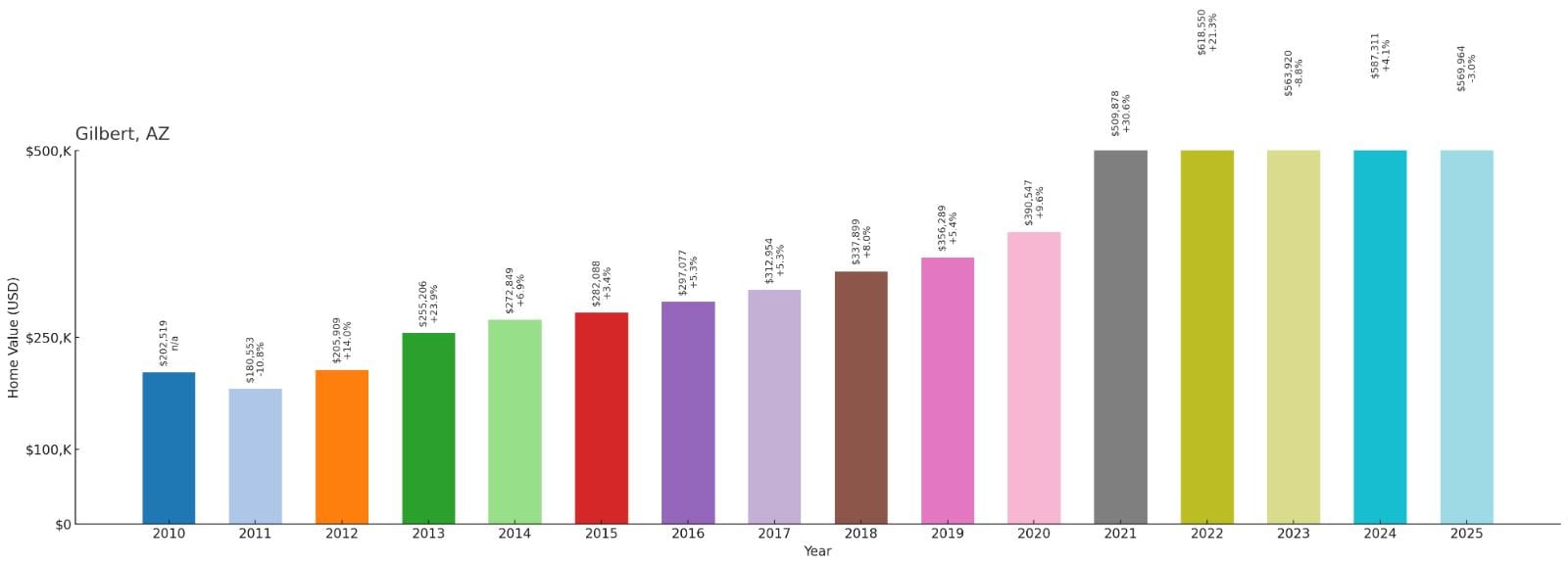
- 2010: $202,519
- 2011: $180,553
- 2012: $205,909
- 2013: $255,206
- 2014: $272,849
- 2015: $282,088
- 2016: $297,077
- 2017: $312,954
- 2018: $337,899
- 2019: $356,289
- 2020: $390,547
- 2021: $509,878
- 2022: $618,550
- 2023: $563,920
- 2024: $587,311
- 2025: $569,964
Gilbert shows remarkable appreciation with home values nearly tripling from around $203,000 in 2010 to nearly $570,000 in 2025. The town experienced steady growth through the 2010s before dramatic acceleration during 2020-2022, when prices jumped from around $391,000 to over $618,000. Current values reflect some cooling but remain well above historic norms.
Why Gilbert?
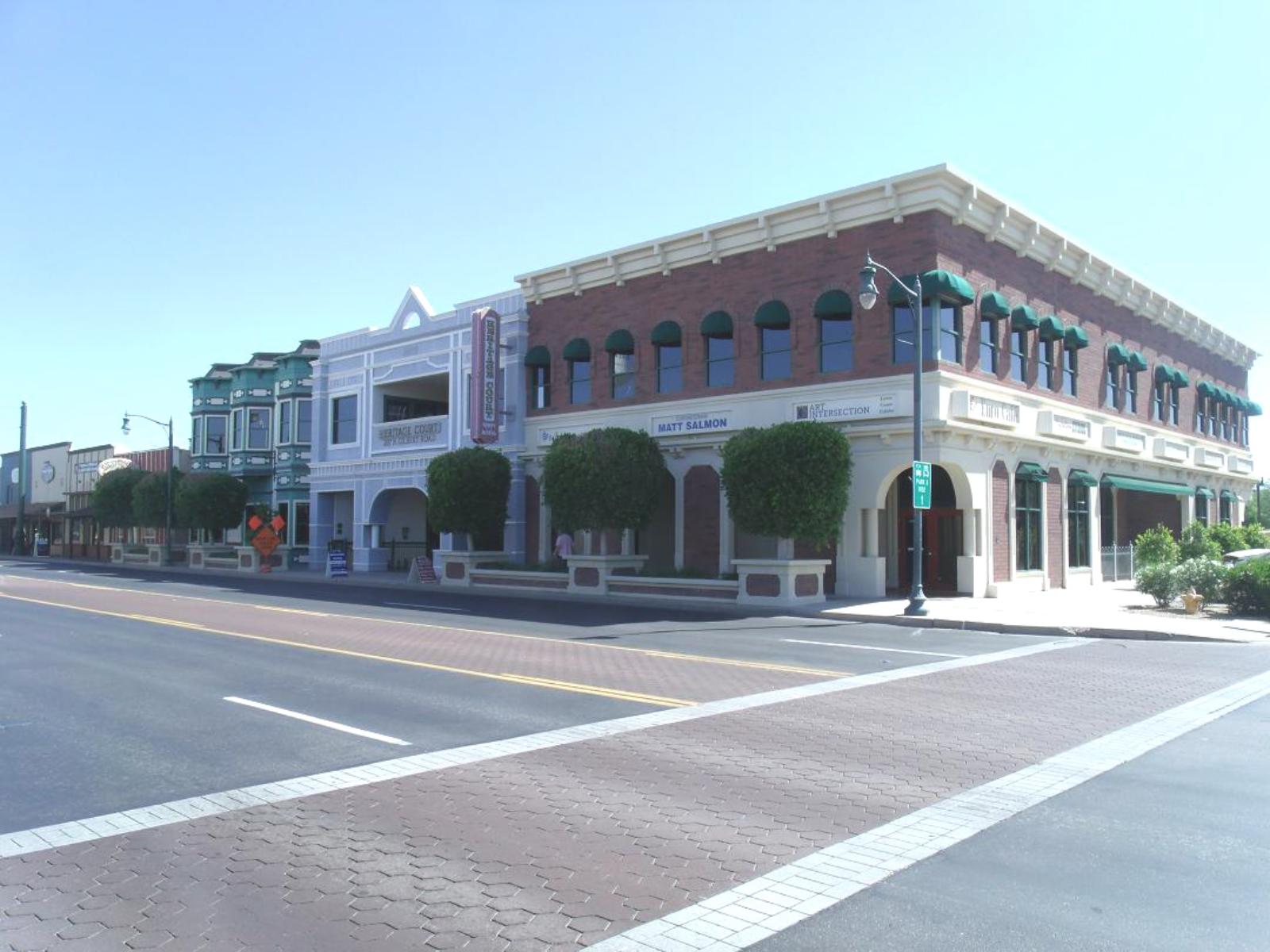
Why are people willing to pay so much to live here? What’s special about it?
Gilbert attracts families with its combination of excellent schools, master-planned communities, and family-friendly amenities including numerous parks and recreation facilities. The town has earned recognition for safety, quality of life, and community planning that creates an ideal suburban environment. Buyers value the newer housing stock, planned development, and strong municipal services.
The community’s location in the Southeast Valley provides access to major employment centers while maintaining a newer, less congested feel compared to established Phoenix suburbs. Gilbert’s reputation for excellent schools, safety, and quality of life justifies premium prices for families seeking optimal suburban living in the Phoenix area.
How Gilbert Rose to Prominence
Gilbert was founded in 1902 as an agricultural community by William Gilbert, who developed the town site along the Arizona Eastern Railway. The area thrived on cotton, citrus, and dairy farming through much of the 20th century, remaining largely rural until Phoenix’s suburban growth reached the Southeast Valley.
The town’s transformation began in the 1980s and accelerated through the 1990s as master-planned developments replaced agricultural land. Gilbert’s strategic planning, emphasis on family amenities, and commitment to controlled growth created one of Arizona’s most successful suburban communities, attracting families seeking modern amenities with small-town character.
3 Interesting Tidbits
1. Agricultural Heritage – Gilbert preserved several historic sites including the Gilbert Historical Museum and restored buildings that commemorate its farming and dairy heritage.
2. Water Tower Landmark – The town’s iconic water tower, built in 1927, remains a community symbol and historic landmark in the heart of Gilbert’s historic downtown area.
3. Family Focus – Gilbert has earned recognition as one of America’s best places to raise a family, with numerous parks, youth programs, and family-oriented community events.
16. Sonoita – 98% Home Price Increase Since 2010
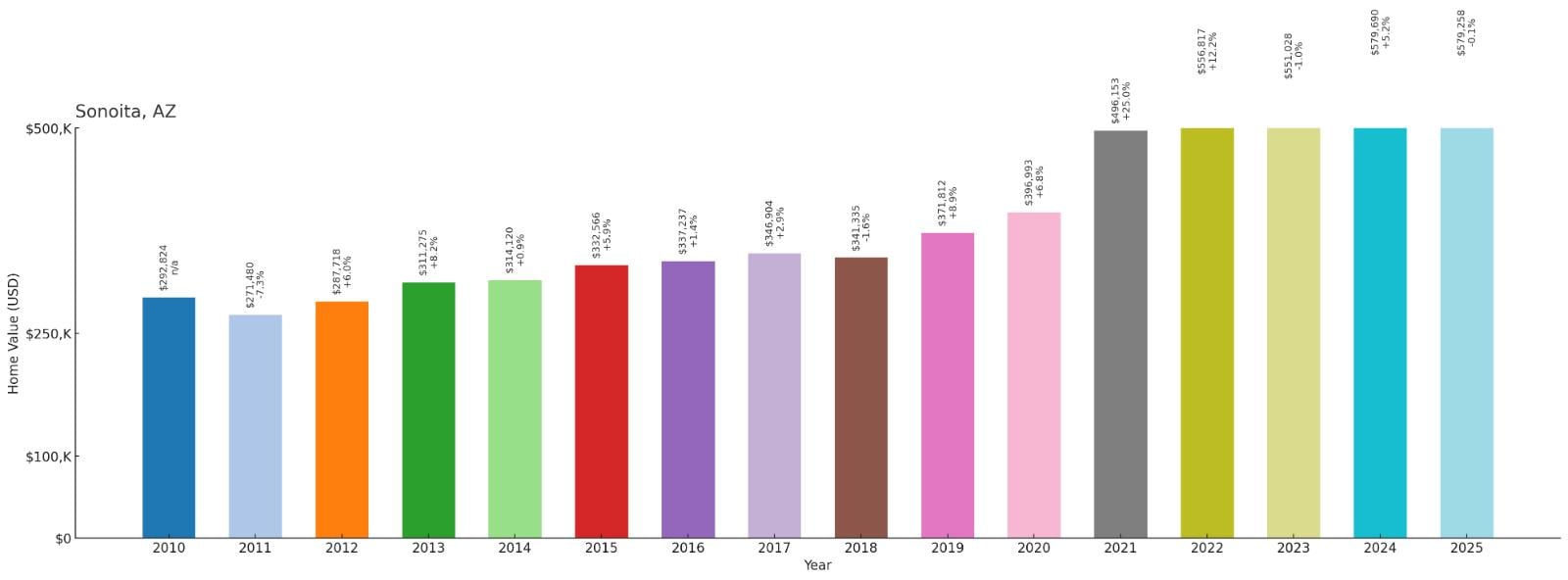
- 2010: $292,824
- 2011: $271,480
- 2012: $287,718
- 2013: $311,275
- 2014: $314,120
- 2015: $332,566
- 2016: $337,237
- 2017: $346,904
- 2018: $341,335
- 2019: $371,812
- 2020: $396,993
- 2021: $496,153
- 2022: $556,817
- 2023: $551,028
- 2024: $579,690
- 2025: $579,258
Sonoita demonstrates solid appreciation with home values nearly doubling from their already elevated 2010 baseline of around $293,000. The community maintained steady growth through the 2010s before experiencing acceleration during 2020-2022, when prices jumped from around $397,000 to over $557,000. Current values near $579,000 show continued strength in this wine country location.
Why Sonoita?

Why are people willing to pay so much to live here? What’s special about it?
Sonoita attracts buyers seeking rural wine country living in Arizona’s scenic high desert southeast of Tucson. The community offers vineyard properties, ranch land, and stunning grassland views that create a unique Arizona lifestyle. Buyers value the area’s elevation, cooler climate, and agricultural character that supports both viticulture and equestrian activities.
The region’s designation as Arizona’s premier wine country adds prestige and tourism appeal, while large lots and rural zoning attract buyers seeking privacy and space for horses or farming. Sonoita’s combination of wine tourism, agricultural heritage, and scenic beauty justifies premium prices for this distinctive high desert community.
How Sonoita Rose to Prominence
Sonoita developed as a railroad stop and ranching community in the late 1800s, taking advantage of the high grasslands’ suitability for cattle operations. The area’s elevation and climate created conditions different from typical Arizona desert environments, supporting both ranching and later agricultural diversification.
The modern wine industry began in the 1970s when pioneering vintners recognized the area’s potential for grape cultivation. This agricultural evolution, combined with the region’s scenic beauty and proximity to Tucson, attracted buyers seeking rural properties with unique character. Sonoita’s wine country designation has enhanced its appeal and property values significantly.
3 Interesting Tidbits
1. Wine Pioneer – Sonoita is home to some of Arizona’s first commercial wineries, established in the 1970s and helping create the state’s wine industry.
2. Grassland Ecosystem – The area features rare Arizona grasslands that resemble Western ranch country more than typical desert landscapes, creating unique scenic appeal.
3. Railroad Heritage – Historic railroad structures and the old Sonoita train depot reflect the community’s origins as a transportation hub in southern Arizona.
15. Munds Park – 178% Home Price Increase Since 2010
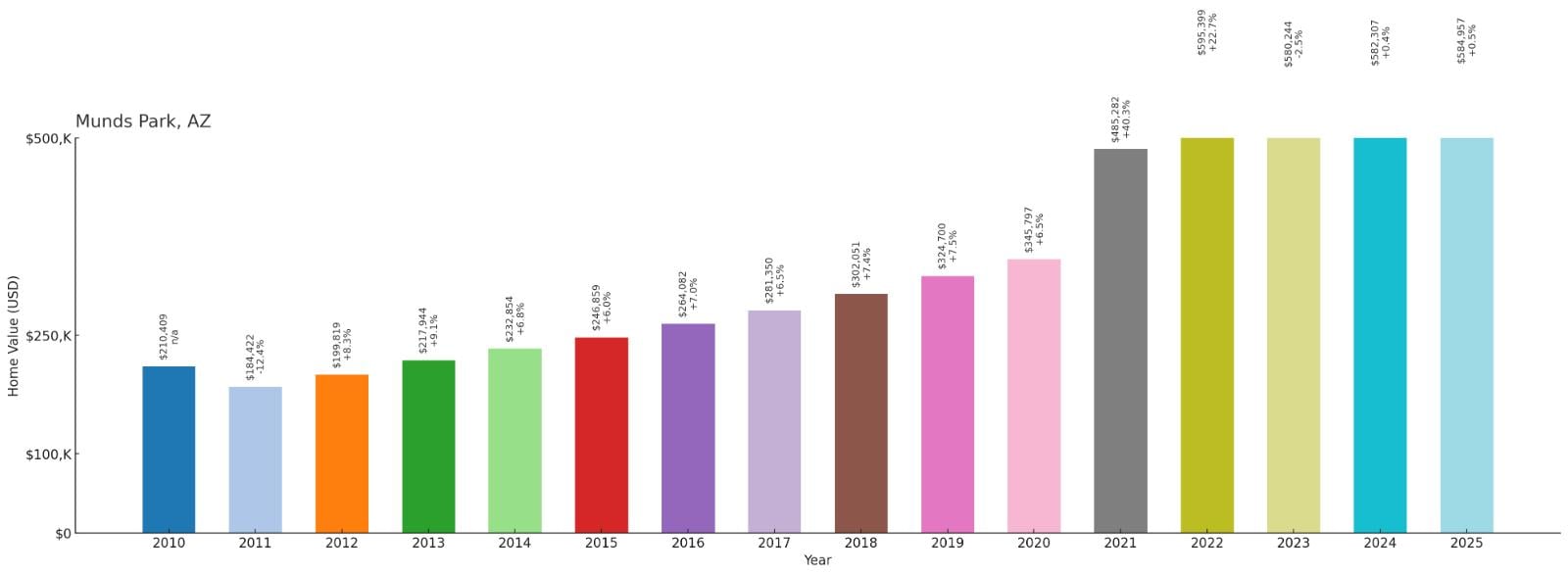
- 2010: $210,409
- 2011: $184,422
- 2012: $199,819
- 2013: $217,944
- 2014: $232,854
- 2015: $246,859
- 2016: $264,082
- 2017: $281,350
- 2018: $302,051
- 2019: $324,700
- 2020: $345,797
- 2021: $485,282
- 2022: $595,399
- 2023: $580,244
- 2024: $582,307
- 2025: $584,957
Munds Park exhibits exceptional growth with home values nearly tripling from their 2010 starting point. The mountain community showed steady appreciation through the 2010s before experiencing dramatic acceleration during 2020-2022, when prices surged from around $346,000 to nearly $595,000. Current values near $585,000 demonstrate sustained strength in this Flagstaff-area mountain retreat.
Why Munds Park?

Why are people willing to pay so much to live here? What’s special about it?
Munds Park attracts buyers seeking mountain living with proximity to Flagstaff and Sedona, offering pine forests, cooler climate, and outdoor recreation opportunities. The community provides relief from desert heat with its elevation and natural setting that includes hiking trails, wildlife viewing, and four-season mountain experiences. Buyers value the combination of mountain lifestyle and access to regional amenities.
The area’s location between Flagstaff and Sedona creates unique appeal for those wanting mountain living with access to both university town amenities and red rock tourism attractions. Munds Park’s forest setting, recreational opportunities, and strategic location justify premium prices for buyers seeking authentic mountain living in central Arizona.
How Munds Park Rose to Prominence
Munds Park began as a logging and railroad community in the late 1800s, taking advantage of the area’s pine forests and location along transportation routes between Flagstaff and central Arizona. The community developed around timber operations that supplied lumber for regional construction and mining activities.
As logging declined, the area evolved into a recreational destination and mountain retreat community. Munds Park’s natural amenities, cooler climate, and proximity to both Flagstaff and Sedona attracted vacation home buyers and those seeking alternatives to urban development while remaining connected to regional attractions and amenities.
3 Interesting Tidbits
1. Forest Gateway – Munds Park provides access to Coconino National Forest with hiking trails, camping areas, and outdoor recreation opportunities throughout the surrounding pine forests.
2. Historic Logging – The community preserves remnants of its logging heritage, including historic sawmill sites and logging equipment that reflect its timber industry origins.
3. Elevation Advantage – At over 6,800 feet elevation, Munds Park offers four-season mountain climate with snow in winter and comfortable summers rare in Arizona.
14. Prescott – 147% Home Price Increase Since 2010
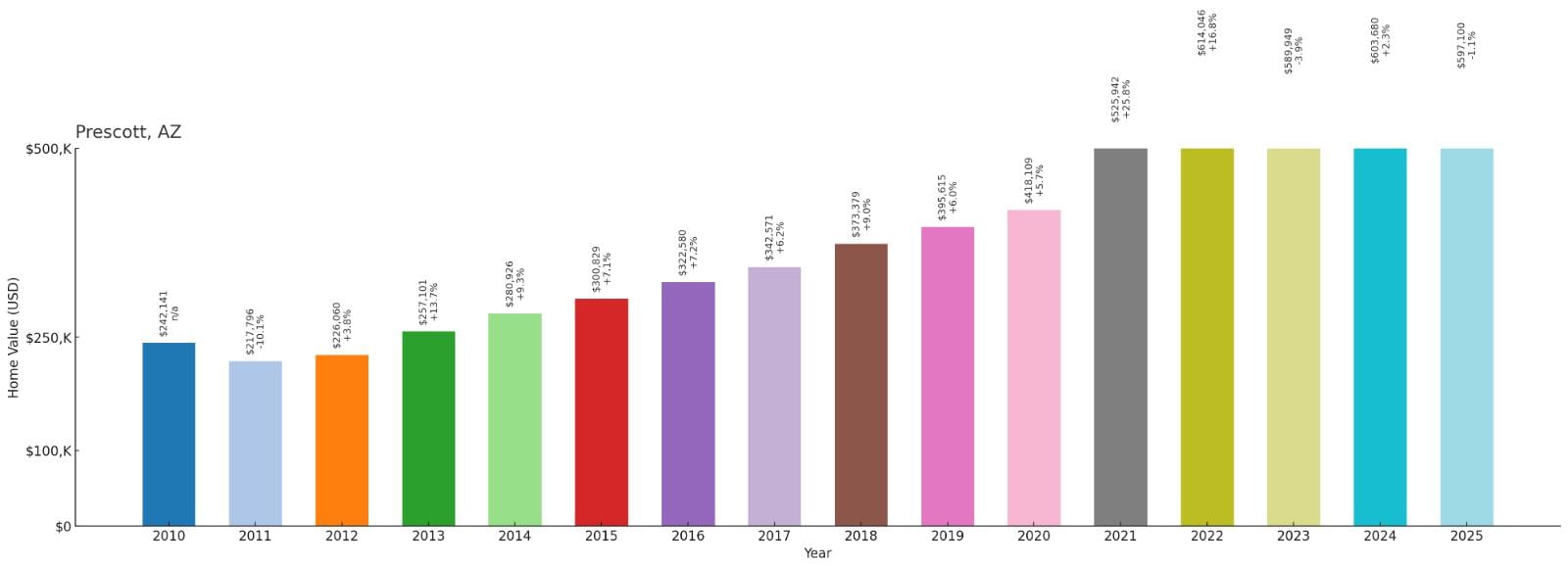
- 2010: $242,141
- 2011: $217,796
- 2012: $226,060
- 2013: $257,101
- 2014: $280,926
- 2015: $300,829
- 2016: $322,580
- 2017: $342,571
- 2018: $373,379
- 2019: $395,615
- 2020: $418,109
- 2021: $525,942
- 2022: $614,046
- 2023: $589,949
- 2024: $603,680
- 2025: $597,100
Prescott shows impressive appreciation with home values more than doubling from their 2010 baseline. The city maintained strong upward momentum through the 2010s before experiencing significant acceleration during 2020-2022, when prices jumped from around $418,000 to over $614,000. Current values near $597,000 reflect this historic mountain city’s sustained appeal.
Why Prescott?

Why are people willing to pay so much to live here? What’s special about it?
Prescott attracts buyers with its combination of historic charm, mountain climate, and small-city amenities including cultural attractions, healthcare facilities, and educational institutions. The city offers cooler temperatures, four-season weather, and outdoor recreation while maintaining urban conveniences that appeal to retirees and families alike. Buyers value the balance of mountain living with city services.
The community’s Victorian architecture, historic courthouse square, and preserved downtown create unique character that sets it apart from typical Arizona development. Prescott’s combination of history, culture, mountain setting, and modern amenities justifies premium prices for buyers seeking distinctive Arizona living experiences.
How Prescott Rose to Prominence
Prescott was founded in 1864 as Arizona’s territorial capital, chosen for its central location and moderate mountain climate. The city developed around government offices, mining operations, and military installations including Fort Whipple. Its Victorian architecture and planned downtown reflected territorial ambitions and early prosperity.
After losing territorial capital status to Phoenix, Prescott evolved into a regional center for ranching, lumber, and later tourism and retirement living. The city’s historic character, mountain setting, and four-season climate attracted retirees and others seeking alternatives to desert living while maintaining urban amenities and cultural attractions.
3 Interesting Tidbits
1. Territorial Capital – Prescott served as Arizona’s first territorial capital from 1864-1867 and again from 1877-1889, creating historic government buildings and Victorian architecture.
2. Courthouse Square – The historic courthouse square remains the heart of downtown Prescott, hosting community events and preserving the city’s territorial-era character.
3. Granite Dells – The unique granite rock formations surrounding Prescott create distinctive scenery and recreation opportunities including hiking, rock climbing, and photography.
13. Parks – 160% Home Price Increase Since 2010

- 2010: $235,416
- 2011: $210,089
- 2012: $210,153
- 2013: $211,153
- 2014: $246,230
- 2015: $270,329
- 2016: $283,808
- 2017: $310,574
- 2018: $337,907
- 2019: $364,028
- 2020: $384,424
- 2021: $497,058
- 2022: $595,202
- 2023: $583,929
- 2024: $599,940
- 2025: $613,162
Parks demonstrates exceptional growth with home values more than doubling since 2010, despite early market volatility through 2013. The community established strong upward momentum beginning in 2014 before experiencing dramatic acceleration during 2020-2022, when prices surged from around $384,000 to nearly $595,000. Current values above $613,000 show continued strength in this northern Arizona location.
Why Parks?
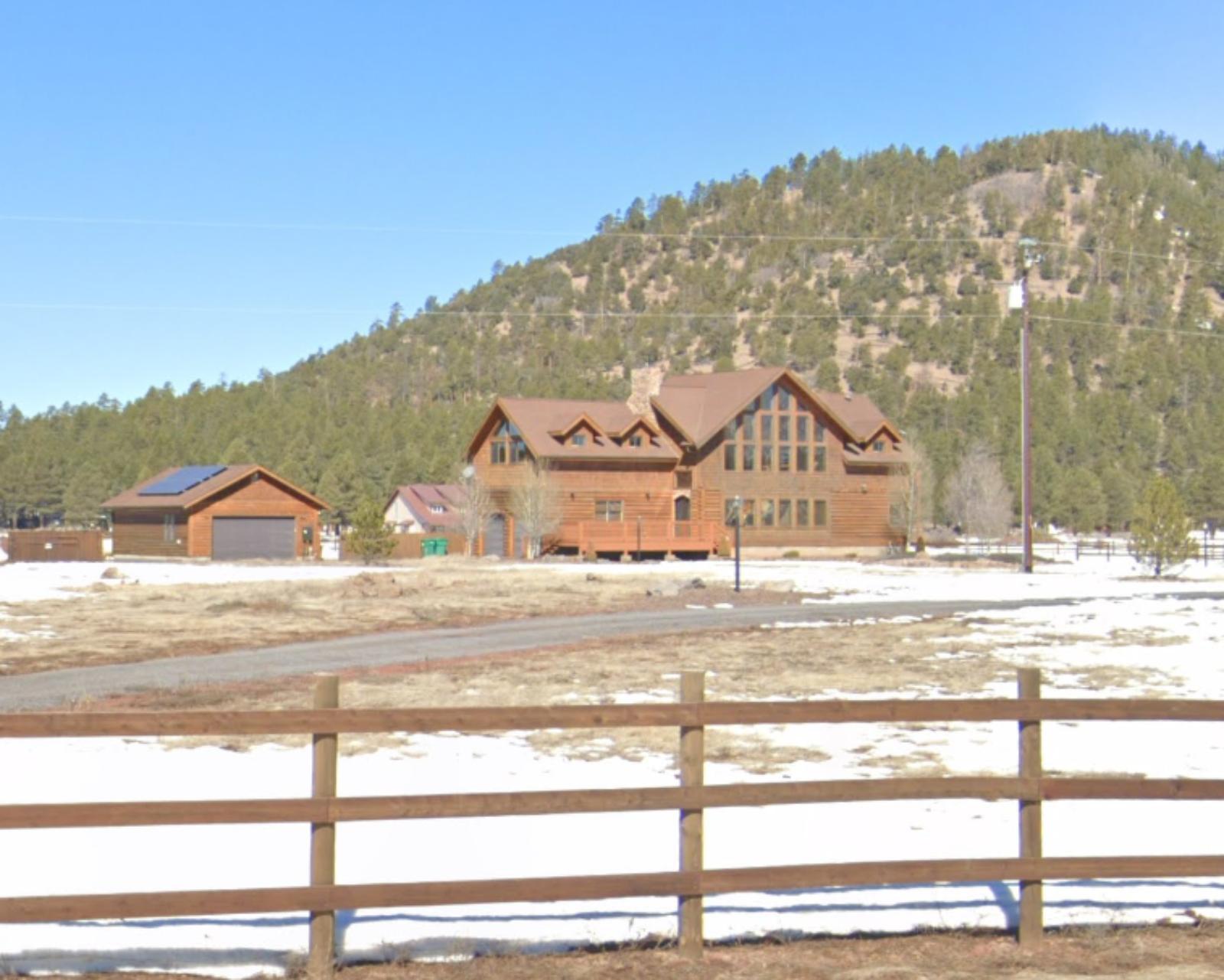
Why are people willing to pay so much to live here? What’s special about it?
Parks attracts buyers seeking mountain living with proximity to Flagstaff and Grand Canyon tourism, offering pine forests, cooler climate, and rural character. The community provides larger lots, horse properties, and outdoor recreation opportunities while maintaining access to Flagstaff’s amenities and employment. Buyers value the combination of mountain lifestyle with convenient location.
The area’s elevation provides relief from desert heat while supporting equestrian activities and rural pursuits that are increasingly rare in Arizona. Parks’ position near major tourist destinations adds tourism appeal and economic stability, while its forest setting and rural character justify premium prices for mountain living experiences.
How Parks Rose to Prominence
Parks developed as a railroad stop and logging community in the late 1800s along the Santa Fe Railway route to the Grand Canyon. The area served as a supply point for lumber operations and later supported ranching and agricultural activities in the high country south of Flagstaff.
The community’s proximity to Flagstaff and Grand Canyon tourism created opportunities for growth as the region developed recreational and tourism industries. Parks’ rural character, mountain setting, and strategic location attracted buyers seeking alternatives to urban development while remaining connected to northern Arizona’s attractions and economic opportunities.
3 Interesting Tidbits
1. Railroad Heritage – Parks originated as a Santa Fe Railway stop serving logging operations and Grand Canyon tourism, with historic railroad infrastructure still visible in the community.
2. Grand Canyon Gateway – The community’s location provides convenient access to Grand Canyon National Park and related tourism activities that support the local economy.
3. High Country Setting – Parks sits in the high country pine forests south of Flagstaff, offering mountain living with four-season climate and forest recreation opportunities.
12. Tortolita – 82% Home Price Increase Since 2010

- 2010: $342,396
- 2011: $307,054
- 2012: $275,851
- 2013: $295,608
- 2014: $311,901
- 2015: $321,850
- 2016: $332,731
- 2017: $364,297
- 2018: $379,375
- 2019: $393,838
- 2020: $417,951
- 2021: $525,116
- 2022: $593,105
- 2023: $591,210
- 2024: $608,295
- 2025: $621,609
Tortolita shows steady appreciation with values rising from an already elevated 2010 baseline of around $342,000 to over $621,000. The community weathered early market volatility before establishing consistent growth through the 2010s. The most significant acceleration occurred during 2020-2022, when prices jumped from around $418,000 to nearly $593,000.
Why Tortolita?
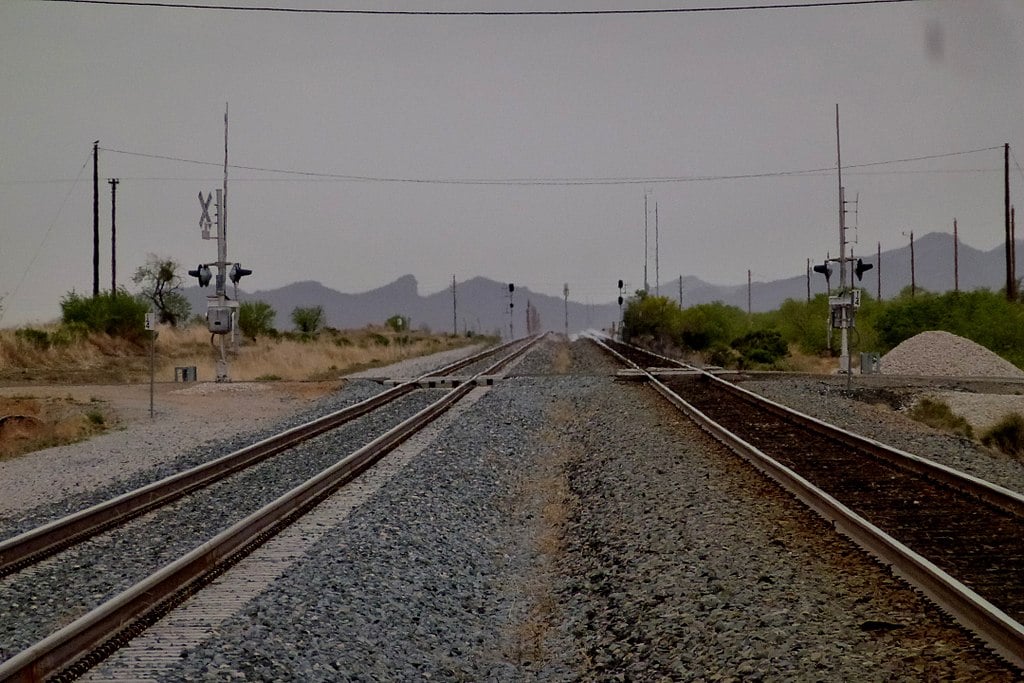
Why are people willing to pay so much to live here? What’s special about it?
Tortolita attracts buyers seeking luxury desert living in a master-planned community north of Tucson with golf courses, mountain views, and upscale amenities. The community offers larger lots, custom homes, and resort-style living while maintaining proximity to Tucson’s employment centers and cultural attractions. Buyers value the combination of luxury amenities with natural desert beauty.
The area’s location in the Tortolita Mountains foothills provides stunning scenery and hiking access while offering planned community amenities including golf and recreation facilities. Tortolita’s master-planned development, mountain setting, and luxury focus justify premium prices for buyers seeking upscale desert living near Tucson.
How Tortolita Rose to Prominence
Tortolita developed as a master-planned community in the 1980s and 1990s, designed to take advantage of the scenic Tortolita Mountains setting north of Tucson. The development emphasized luxury homes, golf courses, and preservation of natural desert landscapes to create an upscale residential environment.
The community’s planned approach integrated custom home sites with recreational amenities while preserving mountain views and desert character. Tortolita’s master-planned design, combined with its scenic location and proximity to Tucson, attracted buyers seeking luxury desert living with modern amenities and natural beauty.
3 Interesting Tidbits
1. Mountain Setting – Tortolita sits in the foothills of the Tortolita Mountains, providing dramatic desert mountain scenery and hiking access throughout the surrounding peaks.
2. Golf Community – The area features championship golf courses that take advantage of the mountain setting and desert landscapes to create premium recreational amenities.
3. Desert Preservation – The master-planned development preserved significant natural desert areas and mountain access, maintaining the area’s natural character alongside residential development.
11. Queen Creek – 217% Home Price Increase Since 2010
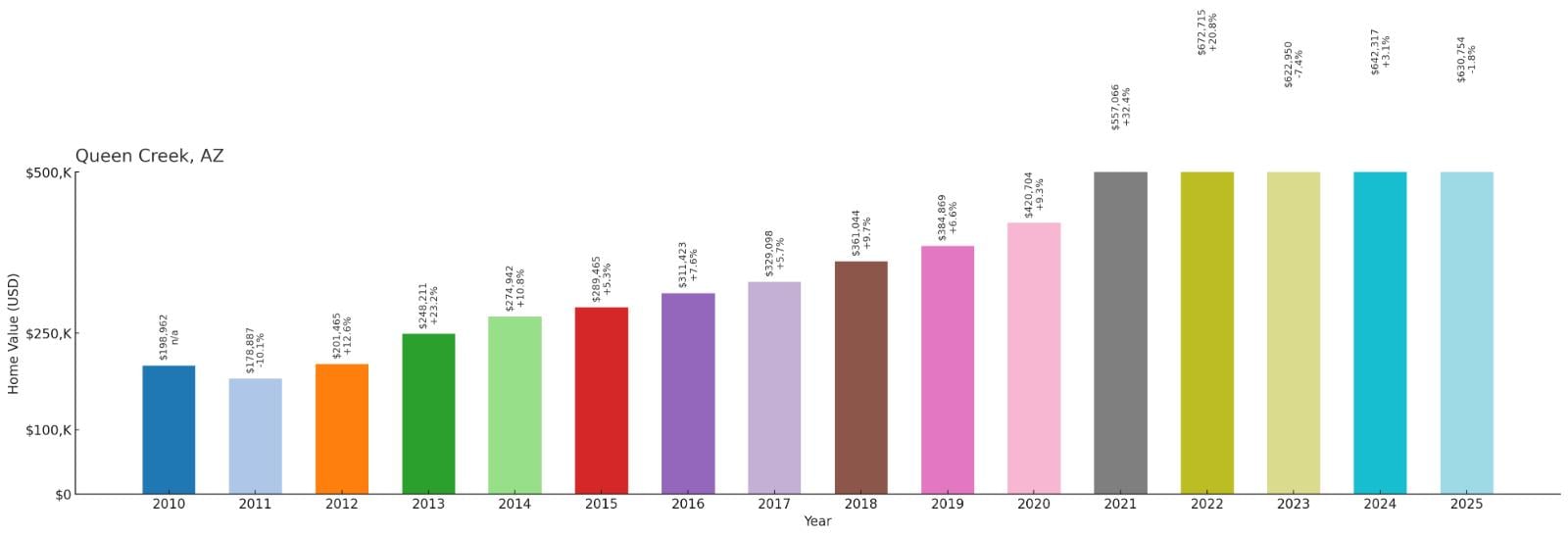
- 2010: $198,962
- 2011: $178,887
- 2012: $201,465
- 2013: $248,211
- 2014: $274,942
- 2015: $289,465
- 2016: $311,423
- 2017: $329,098
- 2018: $361,044
- 2019: $384,869
- 2020: $420,704
- 2021: $557,066
- 2022: $672,715
- 2023: $622,950
- 2024: $642,317
- 2025: $630,754
Queen Creek exhibits remarkable growth with home values more than tripling from around $199,000 in 2010 to over $630,000 in 2025. The town experienced steady appreciation through the 2010s before explosive growth during 2020-2022, when prices surged from around $421,000 to nearly $673,000. Current values reflect some market cooling but remain more than triple their starting point.
Why Queen Creek?
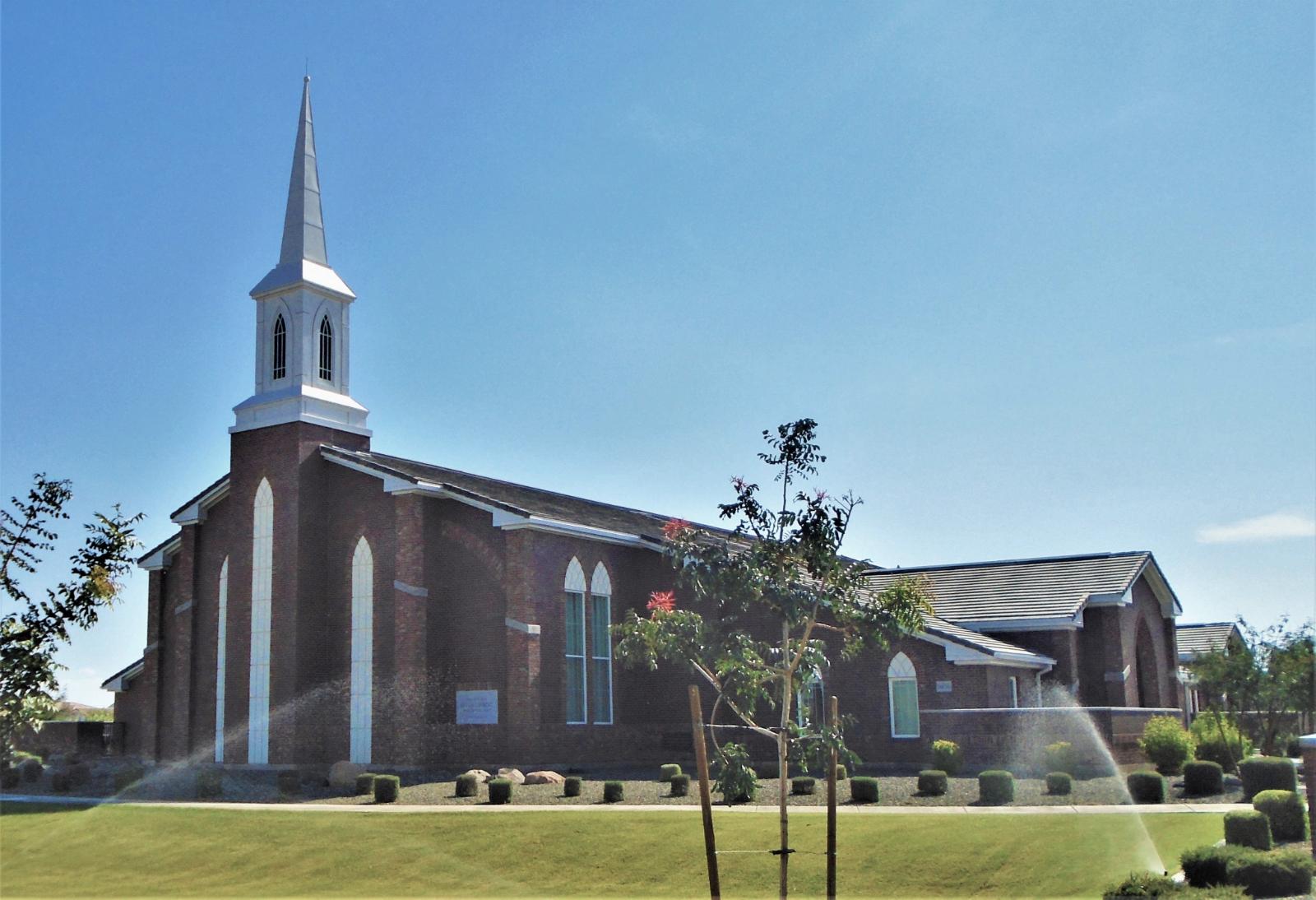
Why are people willing to pay so much to live here? What’s special about it?
Queen Creek attracts families seeking master-planned communities with excellent schools, newer housing, and family-oriented amenities in the Southeast Valley. The town offers abundant parks, recreation facilities, and planned developments that create an ideal suburban environment. Buyers value the newer infrastructure, quality construction, and community planning that emphasizes family life.
The area’s rapid but controlled growth has maintained quality while providing modern amenities and services that appeal to young families and professionals. Queen Creek’s combination of master-planned excellence, family focus, and strategic location justifies premium prices for buyers seeking optimal suburban living in the Phoenix area.
How Queen Creek Rose to Prominence
Queen Creek originated as an agricultural community in the late 1800s, named for Queen Creek wash that flows through the area during seasonal rains. The town remained largely rural and agricultural through much of the 20th century, with cotton, alfalfa, and dairy farming dominating the local economy.
The transformation began in the 1980s and accelerated through the 1990s and 2000s as master-planned developments replaced agricultural land. Queen Creek’s strategic planning, emphasis on family amenities, and commitment to controlled growth created one of Arizona’s fastest-growing and most successful suburban communities, attracting families from across the Phoenix metropolitan area.
3 Interesting Tidbits
1. Agricultural Heritage – Queen Creek preserves its farming heritage through the annual Olive Mill event and historic agricultural sites that commemorate the area’s rural origins.
2. Planned Growth – The town has earned recognition for smart growth planning that balances development with open space preservation and community amenities.
3. Family Focus – Queen Creek consistently ranks among the best places to raise a family in Arizona, with numerous parks, youth programs, and family-oriented community facilities.
10. Flagstaff – 154% Home Price Increase Since 2010
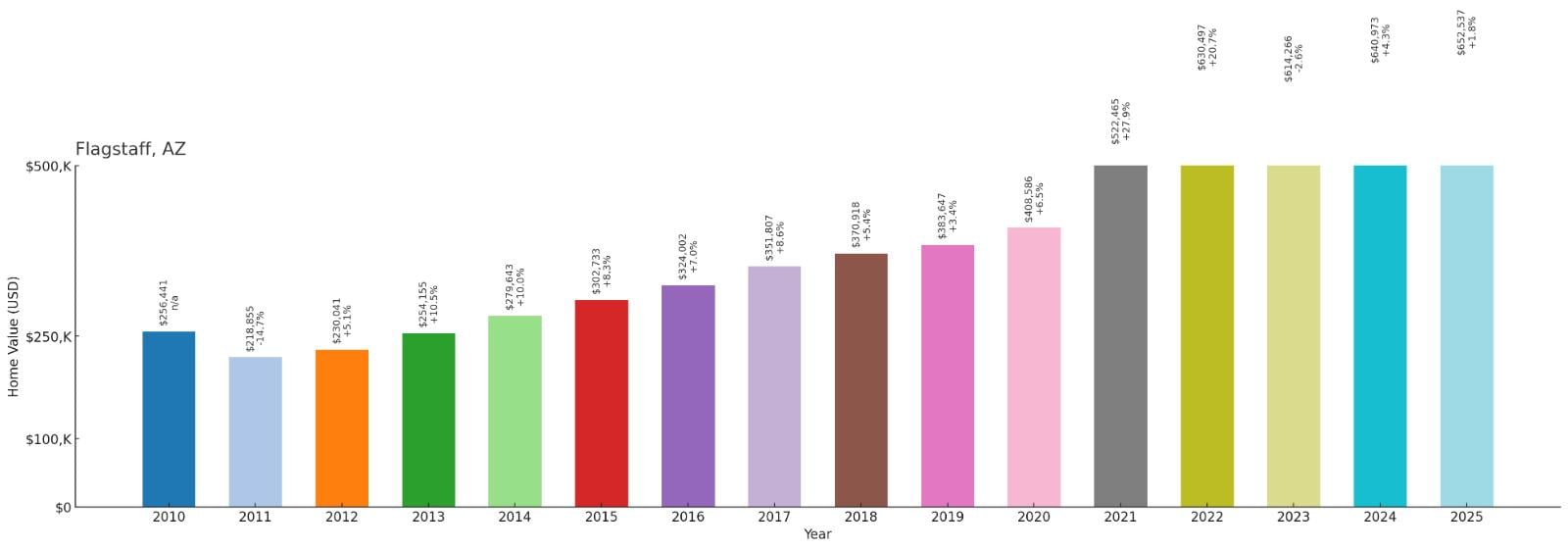
- 2010: $256,441
- 2011: $218,855
- 2012: $230,041
- 2013: $254,155
- 2014: $279,643
- 2015: $302,733
- 2016: $324,002
- 2017: $351,807
- 2018: $370,918
- 2019: $383,647
- 2020: $408,586
- 2021: $522,465
- 2022: $630,497
- 2023: $614,266
- 2024: $640,973
- 2025: $652,537
Flagstaff demonstrates strong appreciation with home values more than doubling since 2010, despite early volatility through 2011-2012. The city maintained steady growth through the 2010s before experiencing dramatic acceleration during 2020-2022, when prices jumped from around $409,000 to over $630,000. Current values above $652,000 show continued strength in this mountain university city.
Why Flagstaff?
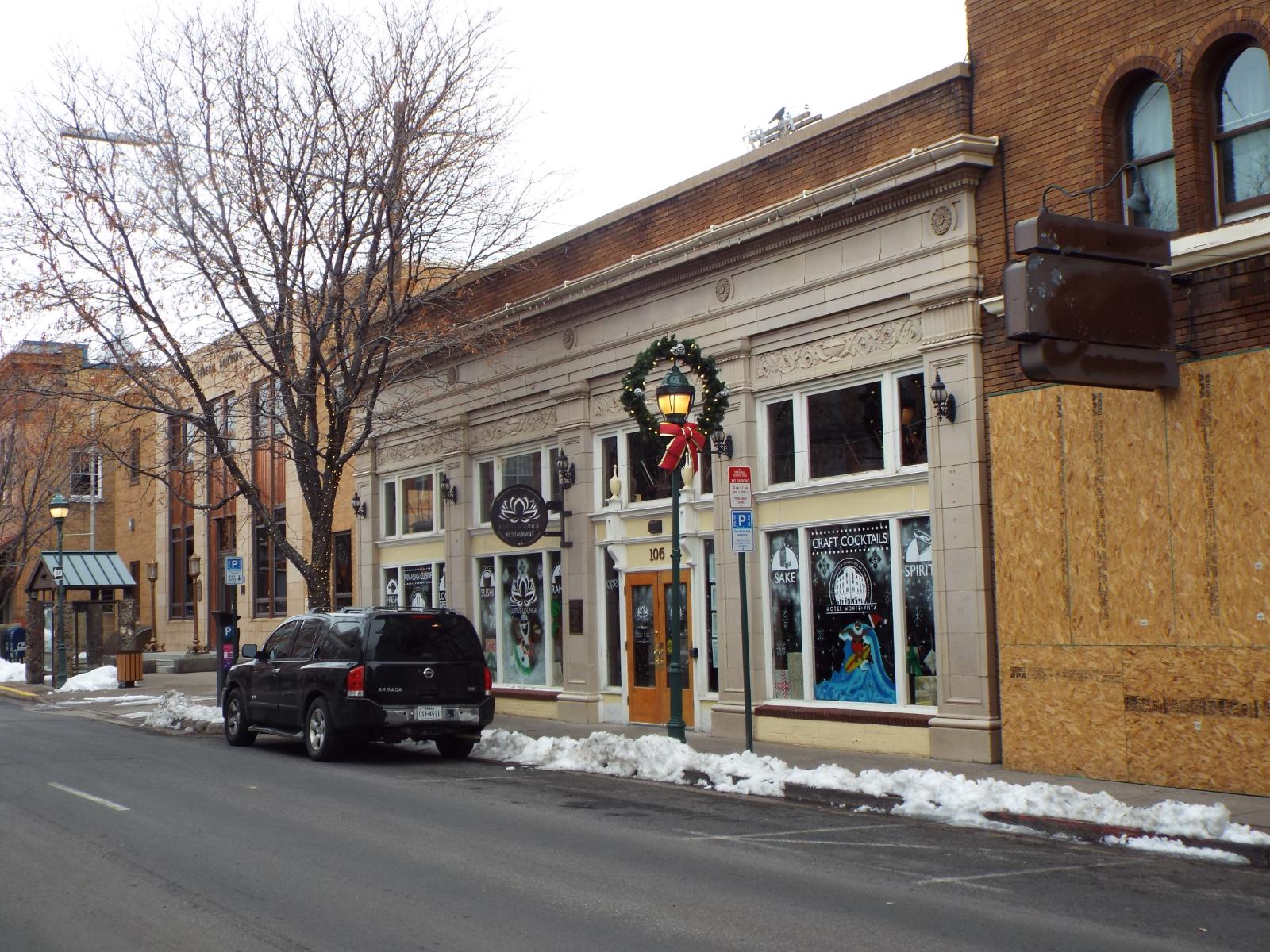
Why are people willing to pay so much to live here? What’s special about it?
Flagstaff attracts buyers with its combination of university town amenities, mountain climate, and four-season living that’s rare in Arizona. The city offers cultural attractions, educational opportunities, and outdoor recreation while maintaining small-city character. Buyers value the cooler temperatures, natural beauty, and intellectual atmosphere created by Northern Arizona University.
The area’s proximity to Grand Canyon National Park, ski areas, and national forests creates exceptional recreational opportunities that appeal to outdoor enthusiasts. Flagstaff’s unique combination of education, culture, mountain living, and tourism appeal justifies premium prices for buyers seeking distinctive Arizona experiences.
How Flagstaff Rose to Prominence
Flagstaff was founded in 1876 as a railroad town along the Atlantic & Pacific Railroad route, chosen for its location, water sources, and timber resources. The city developed around railroad operations, lumber mills, and later became a regional center for ranching and tourism to the Grand Canyon.
The establishment of Northern Arizona University in 1899 added educational and cultural dimensions to the community’s economy. Flagstaff’s role as a gateway to Grand Canyon National Park, combined with its mountain setting and university presence, created a unique economy based on education, tourism, and outdoor recreation that attracts diverse residents and supports higher property values.
3 Interesting Tidbits
1. Route 66 Heritage – Historic Route 66 runs through downtown Flagstaff, with vintage motels, diners, and shops that preserve the city’s transportation heritage and attract tourists.
2. Dark Sky City – Flagstaff was the world’s first International Dark Sky City, with lighting ordinances that preserve exceptional stargazing conditions for the Lowell Observatory and residents.
3. Ski Town – Arizona Snowbowl ski area provides winter sports opportunities rare in Arizona, making Flagstaff one of the few places in the state where residents can ski.
9. Fountain Hills – 125% Home Price Increase Since 2010
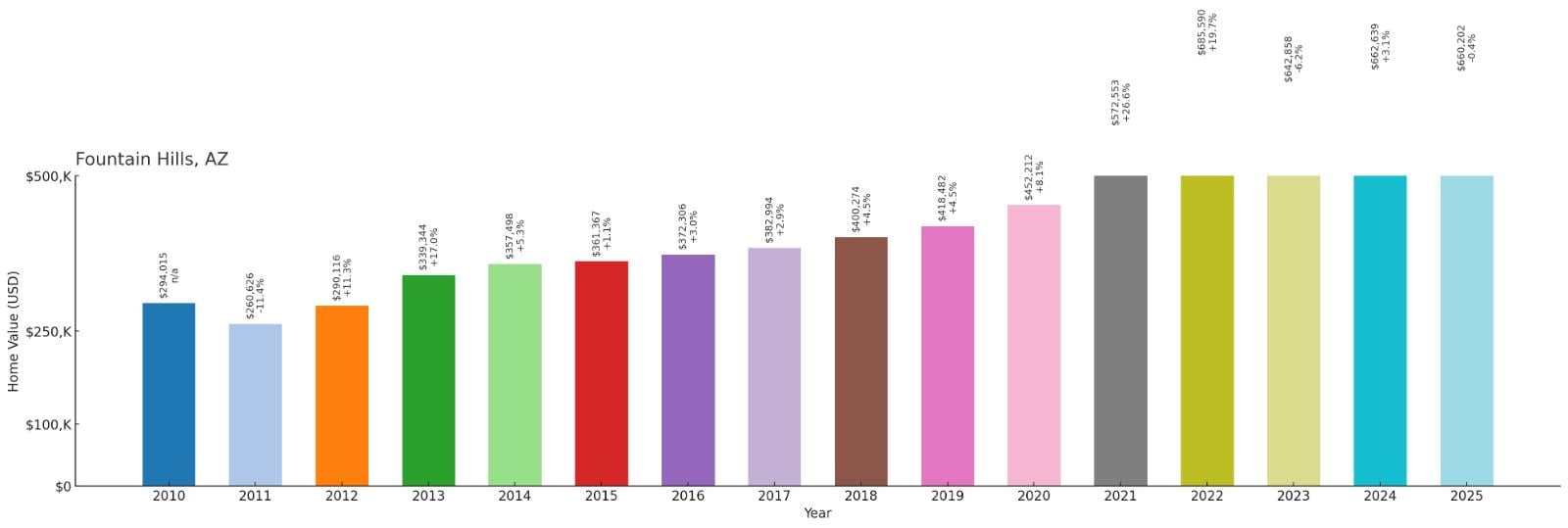
- 2010: $294,015
- 2011: $260,626
- 2012: $290,116
- 2013: $339,344
- 2014: $357,498
- 2015: $361,367
- 2016: $372,306
- 2017: $382,994
- 2018: $400,274
- 2019: $418,482
- 2020: $452,212
- 2021: $572,553
- 2022: $685,590
- 2023: $642,858
- 2024: $662,639
- 2025: $660,202
Fountain Hills shows impressive appreciation with values more than doubling from an already elevated 2010 baseline of around $294,000. The community maintained steady growth through the 2010s before experiencing significant acceleration during 2020-2022, when prices jumped from around $452,000 to nearly $686,000. Current values above $660,000 demonstrate sustained appeal for this Scottsdale-area community.
Why Fountain Hills?

Why are people willing to pay so much to live here? What’s special about it?
Fountain Hills attracts buyers with its iconic fountain, golf courses, and upscale desert living in a master-planned community setting. The town offers luxury amenities, mountain views, and resort-style living while maintaining small-town character. Buyers value the combination of planned development, recreational facilities, and proximity to Scottsdale’s amenities.
The community’s signature fountain, which shoots water over 500 feet high, creates a unique landmark and tourist attraction that adds prestige to the area. Fountain Hills’ master-planned design, luxury focus, and scenic desert setting justify premium prices for buyers seeking upscale suburban living near Scottsdale.
How Fountain Hills Rose to Prominence
Fountain Hills was developed in the 1970s by McCulloch Properties as a master-planned community centered around an artificial lake and the world’s fourth-tallest fountain. The development was designed to create an upscale residential environment that took advantage of scenic desert mountain views and recreational amenities.
The community’s iconic fountain became a landmark and tourist attraction that helped establish Fountain Hills as a distinctive destination within the Phoenix metropolitan area. The town’s master-planned approach, combined with its recreational amenities and proximity to Scottsdale, attracted buyers seeking luxury desert living with modern conveniences.
3 Interesting Tidbits
1. World-Class Fountain – The town’s signature fountain shoots water up to 560 feet high, making it one of the world’s tallest fountains and a unique Arizona landmark.
2. Master-Planned Heritage – Fountain Hills was one of Arizona’s first successful master-planned communities, setting standards for integrated residential and recreational development.
3. Art Community – The town hosts the annual Fountain Festival of Fine Arts & Crafts, one of the Southwest’s premier outdoor art shows that attracts visitors from across the region.
8. New River – 194% Home Price Increase Since 2010
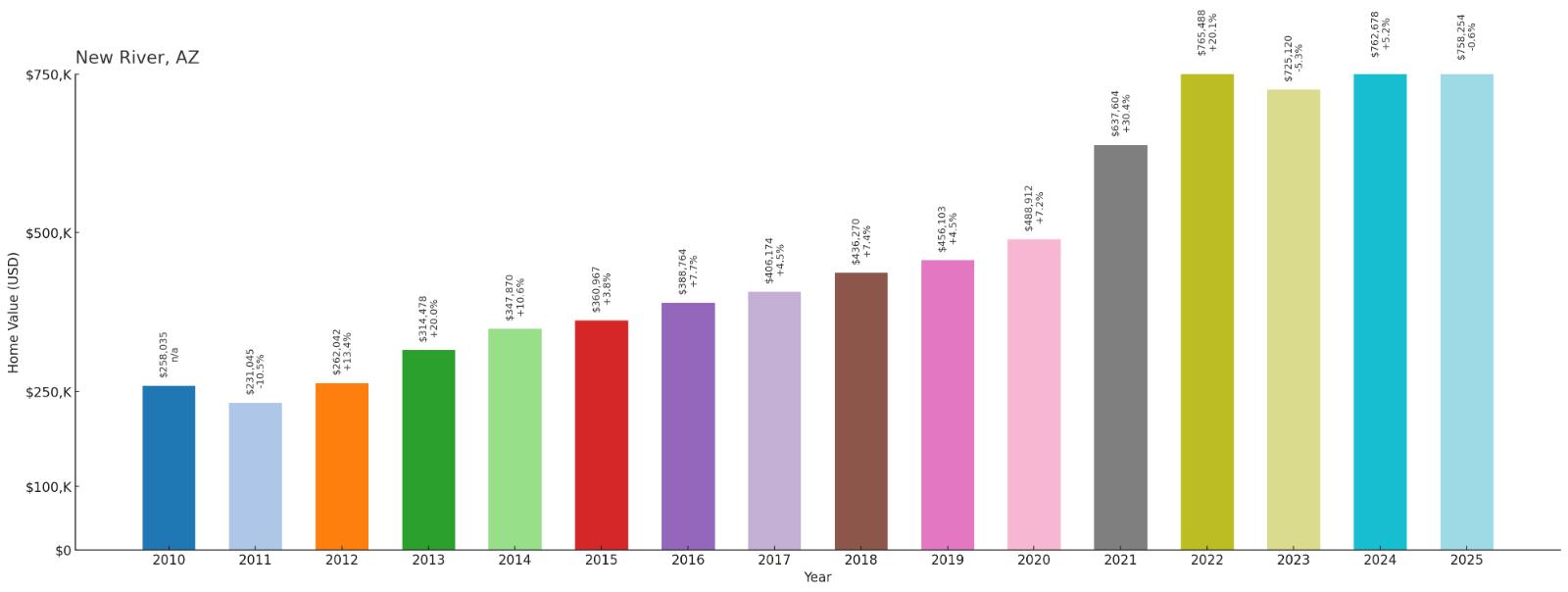
- 2010: $258,035
- 2011: $231,045
- 2012: $262,042
- 2013: $314,478
- 2014: $347,870
- 2015: $360,967
- 2016: $388,764
- 2017: $406,174
- 2018: $436,270
- 2019: $456,103
- 2020: $488,912
- 2021: $637,604
- 2022: $765,488
- 2023: $725,120
- 2024: $762,678
- 2025: $758,254
New River exhibits exceptional growth with home values nearly tripling from around $258,000 in 2010 to over $758,000 in 2025. The community maintained steady appreciation through the 2010s before experiencing explosive growth during 2020-2022, when prices surged from around $489,000 to over $765,000. Current values reflect slight cooling but remain well above historic levels.
Why New River?
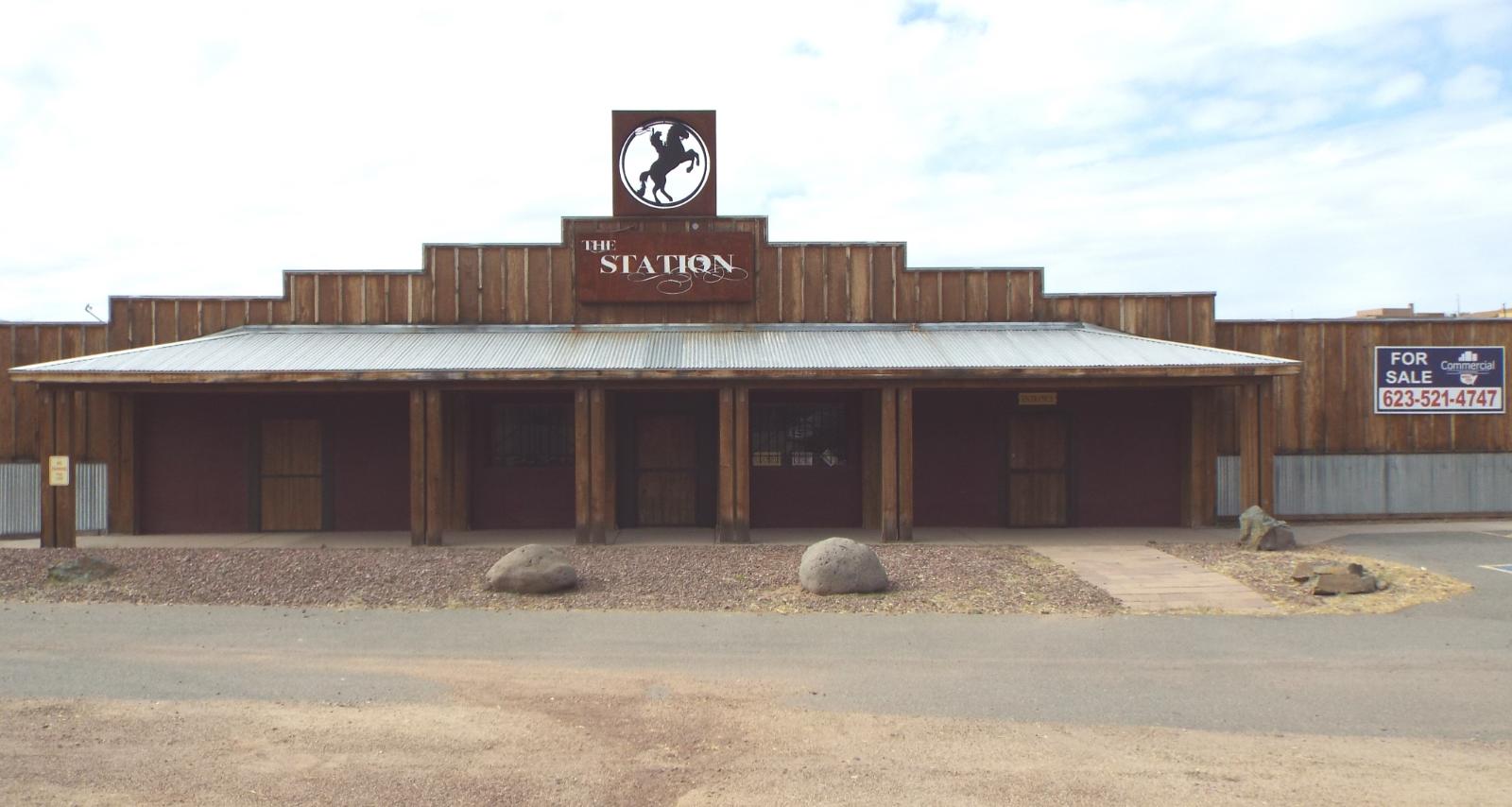
Why are people willing to pay so much to live here? What’s special about it?
New River attracts buyers seeking rural desert living on large lots with mountain views and horse properties north of Phoenix. The community offers privacy, space, and authentic desert lifestyle while maintaining access to metropolitan amenities. Buyers value the area’s rural zoning, custom home opportunities, and stunning Sonoran Desert setting.
The location provides escape from urban density while offering recreational opportunities including hiking, off-road activities, and equestrian pursuits. New River’s combination of rural character, large lots, and proximity to Phoenix justifies premium prices for buyers seeking authentic desert living experiences.
How New River Rose to Prominence
New River developed as a mining and railroad community in the late 1800s, taking advantage of mineral deposits and transportation routes through the desert north of Phoenix. The area later supported ranching and agricultural operations that utilized the desert’s grazing potential and seasonal water sources.
As Phoenix expanded northward, New River attracted buyers seeking rural properties with larger lots and desert character. The community’s rural zoning, natural beauty, and proximity to urban amenities created appeal for those wanting alternatives to suburban development while maintaining access to metropolitan economic opportunities.
3 Interesting Tidbits
1. Desert Ecosystem – New River preserves authentic Sonoran Desert landscape with diverse wildlife, native plants, and desert recreation opportunities that showcase Arizona’s natural heritage.
2. Mining History – Historic mining sites and equipment throughout the area reflect the community’s origins in Arizona’s territorial mining era.
3. Horse Country – The community maintains strong equestrian culture with horse properties, riding trails, and boarding facilities that preserve rural Western character.
7. Rio Verde – 106% Home Price Increase Since 2010
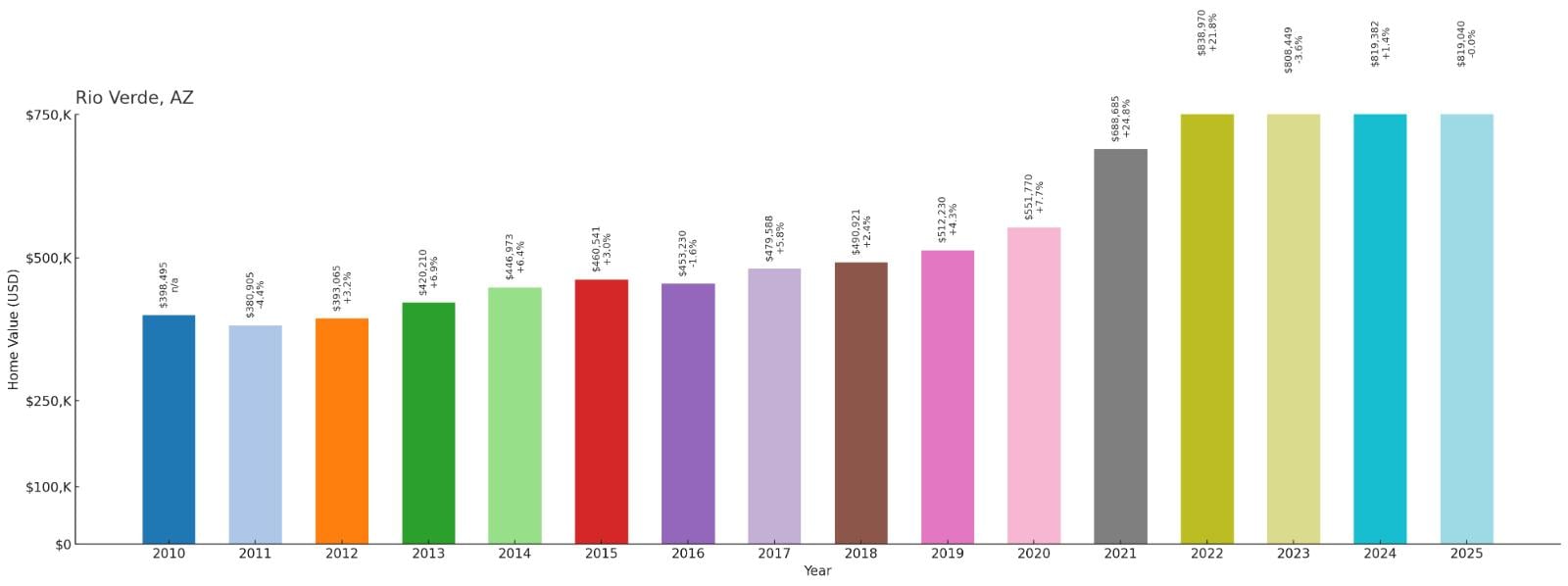
- 2010: $398,495
- 2011: $380,905
- 2012: $393,065
- 2013: $420,210
- 2014: $446,973
- 2015: $460,541
- 2016: $453,230
- 2017: $479,588
- 2018: $490,921
- 2019: $512,230
- 2020: $551,770
- 2021: $688,685
- 2022: $838,970
- 2023: $808,449
- 2024: $819,382
- 2025: $819,040
Rio Verde demonstrates solid appreciation with values more than doubling from an already elevated 2010 baseline of around $398,000. The community maintained steady growth through the 2010s before experiencing dramatic acceleration during 2020-2022, when prices jumped from around $552,000 to nearly $839,000. Current values above $819,000 reflect this desert community’s premium appeal.
Why Rio Verde?
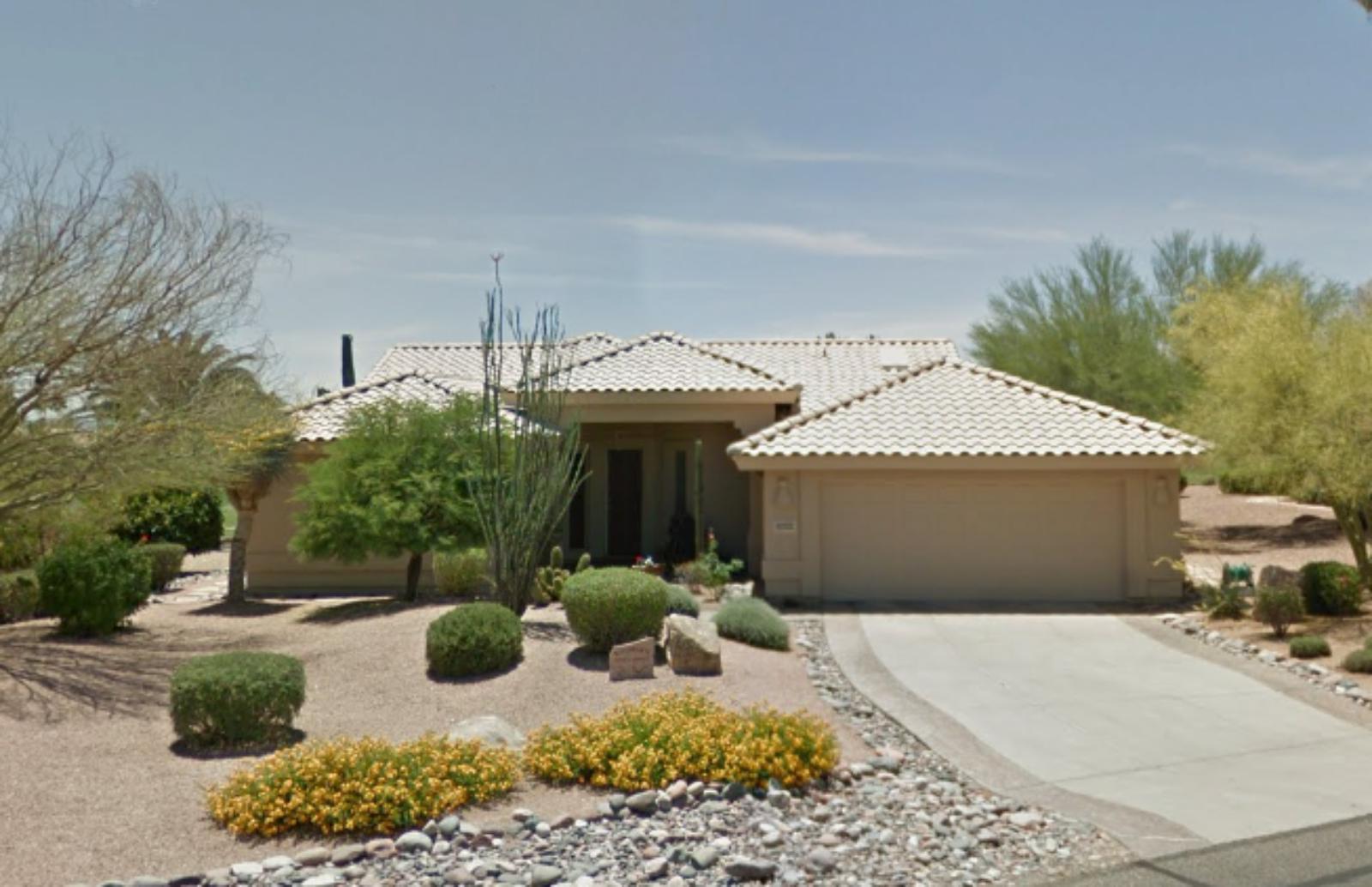
Why are people willing to pay so much to live here? What’s special about it?
Rio Verde attracts buyers seeking luxury desert living on large lots with stunning mountain views and equestrian facilities northeast of Scottsdale. The community offers privacy, custom homes, and authentic Sonoran Desert experiences while maintaining proximity to Scottsdale’s amenities. Buyers value the area’s rural character, horse properties, and scenic desert setting.
The location provides an exclusive desert lifestyle with recreational opportunities including hiking, horseback riding, and off-road activities. Rio Verde’s combination of luxury development, natural beauty, and proximity to upscale amenities justifies premium prices for buyers seeking high-end desert living experiences.
How Rio Verde Rose to Prominence
Rio Verde developed as a rural community northeast of Scottsdale, taking advantage of the area’s scenic desert setting and proximity to the Verde River corridor. The community attracted buyers seeking large lots, horse properties, and custom homes in a rural setting while maintaining access to Scottsdale’s amenities.
The area’s development emphasized preservation of desert character and mountain views while accommodating luxury homes and equestrian facilities. Rio Verde’s rural zoning, natural beauty, and strategic location created appeal for buyers seeking exclusive desert living with modern conveniences and recreational opportunities.
3 Interesting Tidbits
1. Desert Luxury – Rio Verde features custom luxury homes on multi-acre lots that preserve authentic Sonoran Desert landscapes and mountain views.
2. Equestrian Heritage – The community maintains strong horse culture with numerous stables, riding trails, and equestrian events that preserve Western traditions.
3. Verde River Access – Proximity to the Verde River provides recreational opportunities including fishing, bird watching, and riparian habitat exploration rare in desert areas.
6. Scottsdale – 157% Home Price Increase Since 2010
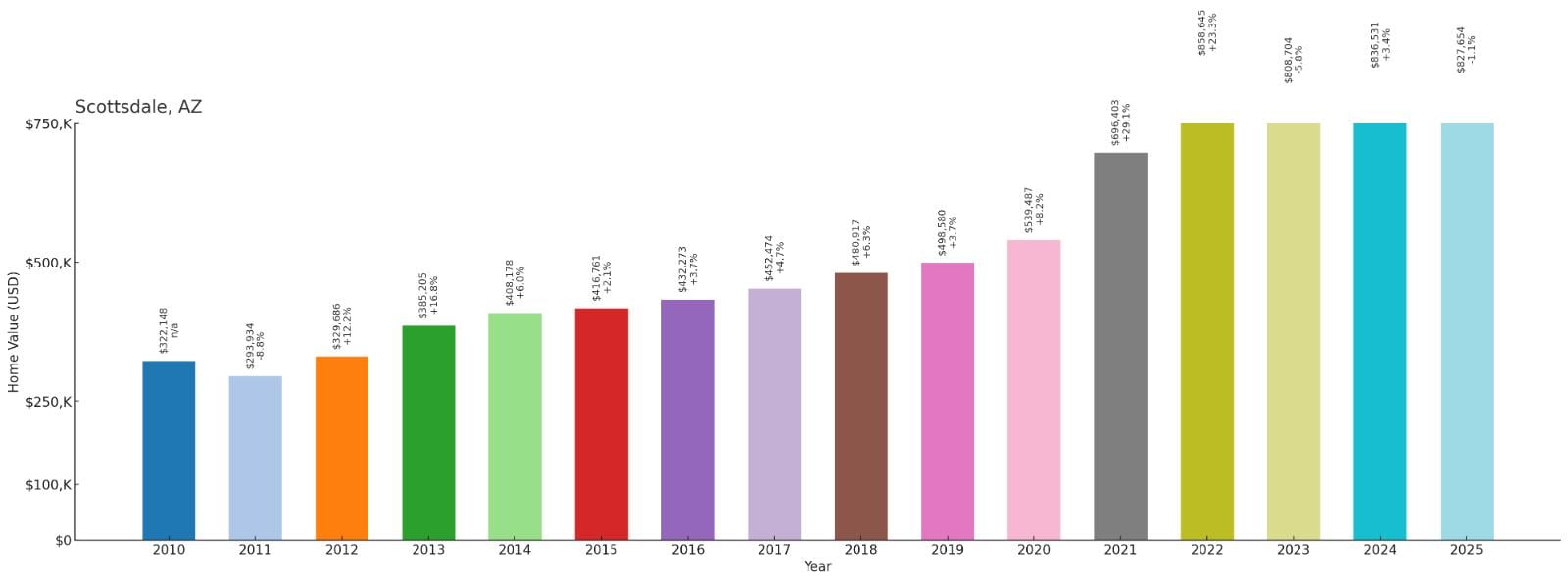
- 2010: $322,148
- 2011: $293,934
- 2012: $329,686
- 2013: $385,205
- 2014: $408,178
- 2015: $416,761
- 2016: $432,273
- 2017: $452,474
- 2018: $480,917
- 2019: $498,580
- 2020: $539,487
- 2021: $696,403
- 2022: $858,645
- 2023: $808,704
- 2024: $836,531
- 2025: $827,654
Scottsdale shows impressive appreciation with home values more than doubling from around $322,000 in 2010 to over $827,000 in 2025. The city maintained steady growth through the 2010s before experiencing dramatic acceleration during 2020-2022, when prices jumped from around $539,000 to nearly $859,000. Current values reflect some market adjustment but remain well above historic levels.
Why Scottsdale?

Why are people willing to pay so much to live here? What’s special about it?
Scottsdale attracts buyers with its reputation as a luxury destination featuring world-class golf courses, upscale shopping, fine dining, and resort amenities. The city offers sophisticated urban living combined with desert beauty and mountain views that create a premium lifestyle experience. Buyers value the combination of cultural attractions, recreational facilities, and high-end amenities.
The area’s year-round sunshine, numerous golf courses, and vibrant arts scene attract both full-time residents and seasonal visitors seeking luxury desert living. Scottsdale’s brand recognition, tourism appeal, and concentration of upscale amenities justify premium prices for buyers seeking prestigious Arizona addresses.
How Scottsdale Rose to Prominence
Scottsdale was founded in 1888 by Army chaplain Winfield Scott, who purchased land in the Salt River Valley for agricultural development. The community remained largely agricultural through the early 20th century before air conditioning and post-war growth transformed it into a resort and retirement destination.
The city’s transformation accelerated in the 1950s and 1960s as luxury resorts, golf courses, and upscale residential developments established Scottsdale as a premier destination. Strategic planning preserved desert character while accommodating growth, creating the sophisticated desert city that attracts affluent residents and visitors from around the world.
3 Interesting Tidbits
1. Golf Capital – Scottsdale features over 200 golf courses, earning recognition as one of the world’s premier golf destinations with courses designed by legendary architects.
2. Art District – The Scottsdale Arts District contains over 100 galleries, making it one of the largest arts destinations in the United States.
3. Old Town Character – Historic Old Town Scottsdale preserves Western heritage with authentic architecture, shops, and restaurants that maintain the city’s frontier character.
5. Sedona – 151% Home Price Increase Since 2010
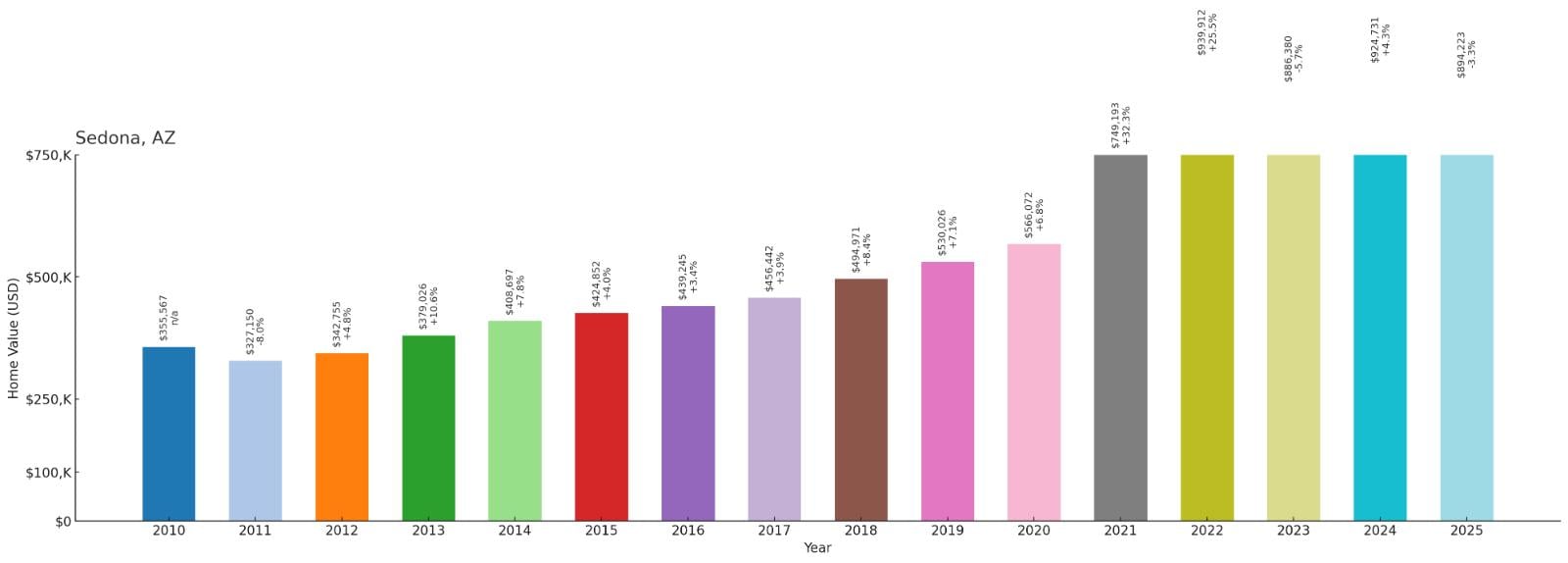
- 2010: $355,567
- 2011: $327,150
- 2012: $342,755
- 2013: $379,026
- 2014: $408,697
- 2015: $424,852
- 2016: $439,245
- 2017: $456,442
- 2018: $494,971
- 2019: $530,026
- 2020: $566,072
- 2021: $749,193
- 2022: $939,912
- 2023: $886,380
- 2024: $924,731
- 2025: $894,223
Sedona demonstrates exceptional growth with home values more than doubling from an already elevated 2010 baseline of around $356,000. The iconic red rock city maintained steady appreciation through the 2010s before experiencing explosive growth during 2020-2022, when prices surged from around $566,000 to nearly $940,000. Current values near $894,000 show continued strength in this world-renowned destination.
Why Sedona?

Why are people willing to pay so much to live here? What’s special about it?
Sedona attracts buyers with its spectacular red rock formations, vibrant arts community, and spiritual tourism that create a unique lifestyle experience. The city offers stunning natural beauty, outdoor recreation, and cultural attractions while maintaining small-town character. Buyers value the combination of scenic splendor, artistic heritage, and tourism appeal that makes Sedona internationally recognized.
The area’s reputation as a spiritual and artistic destination attracts visitors from around the world, supporting a strong tourism economy and cultural amenities. Sedona’s incomparable natural beauty, recreational opportunities, and distinctive character justify premium prices for buyers seeking one of Arizona’s most spectacular settings.
How Sedona Rose to Prominence
Sedona was settled in the late 1800s by pioneers attracted to the area’s red rock beauty and agricultural potential along Oak Creek. The community remained small and isolated until improved roads in the mid-20th century made the area accessible to tourists and artists drawn to its spectacular scenery.
The city gained national attention through Western movies filmed in the red rocks and later through New Age spiritual movements that designated certain rock formations as energy vortexes. This combination of natural beauty, artistic heritage, and spiritual tourism created Sedona’s unique identity as a world-class destination that supports premium real estate values.
3 Interesting Tidbits
1. Red Rock Formations – Sedona’s iconic red sandstone formations create some of the most photographed landscapes in America, attracting millions of visitors annually.
2. Vortex Sites – The area is famous for alleged energy vortexes at specific rock formations that attract spiritual seekers and New Age tourists from around the world.
3. Arts Community – Sedona hosts numerous galleries, studios, and cultural events that have established it as one of the Southwest’s premier arts destinations.
4. Fort McDowell – 93% Home Price Increase Since 2013
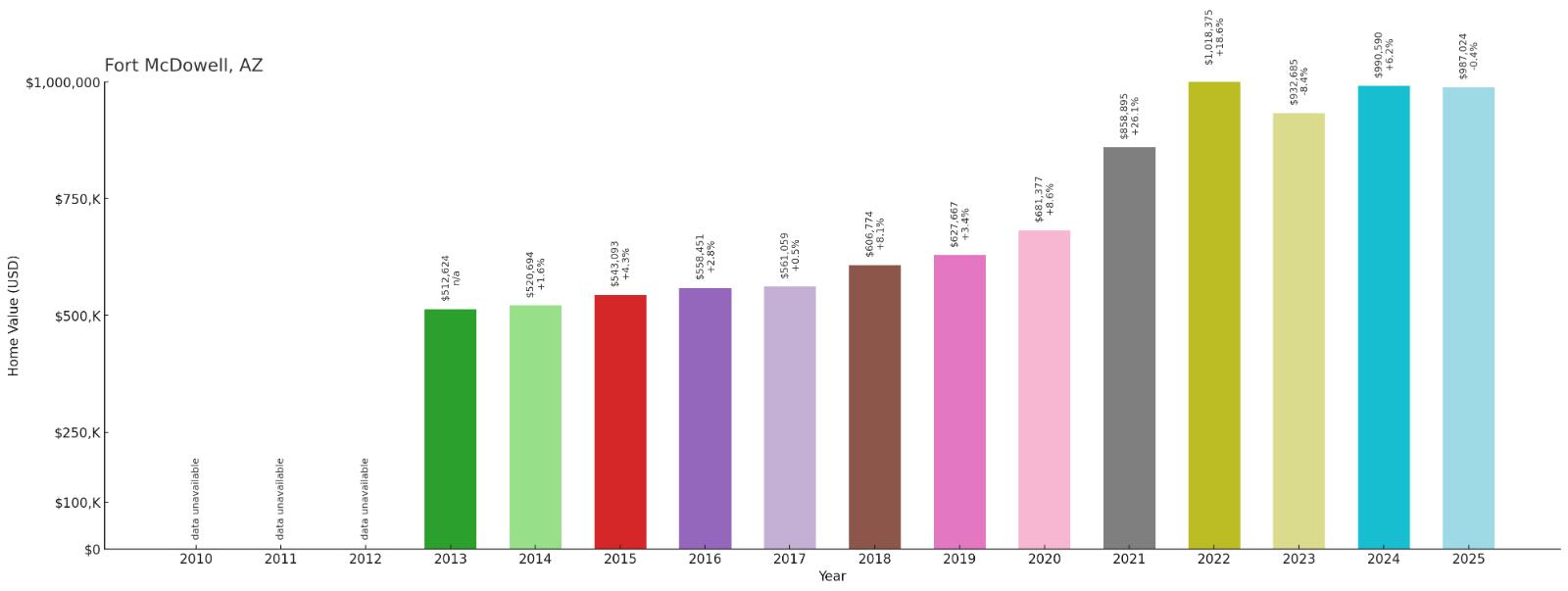
- 2010: N/A
- 2011: N/A
- 2012: N/A
- 2013: $512,624
- 2014: $520,694
- 2015: $543,093
- 2016: $558,451
- 2017: $561,059
- 2018: $606,774
- 2019: $627,667
- 2020: $681,377
- 2021: $858,895
- 2022: $1,018,375
- 2023: $932,685
- 2024: $990,590
- 2025: $987,024
Fort McDowell shows remarkable appreciation in its available data period, with values rising from around $513,000 in 2013 to nearly $987,000 in 2025. The community experienced steady growth through the 2010s before dramatic acceleration during 2020-2022, when prices surged from around $681,000 to over $1 million. Current values near $987,000 position this area among Arizona’s most exclusive communities.
Why Fort McDowell?
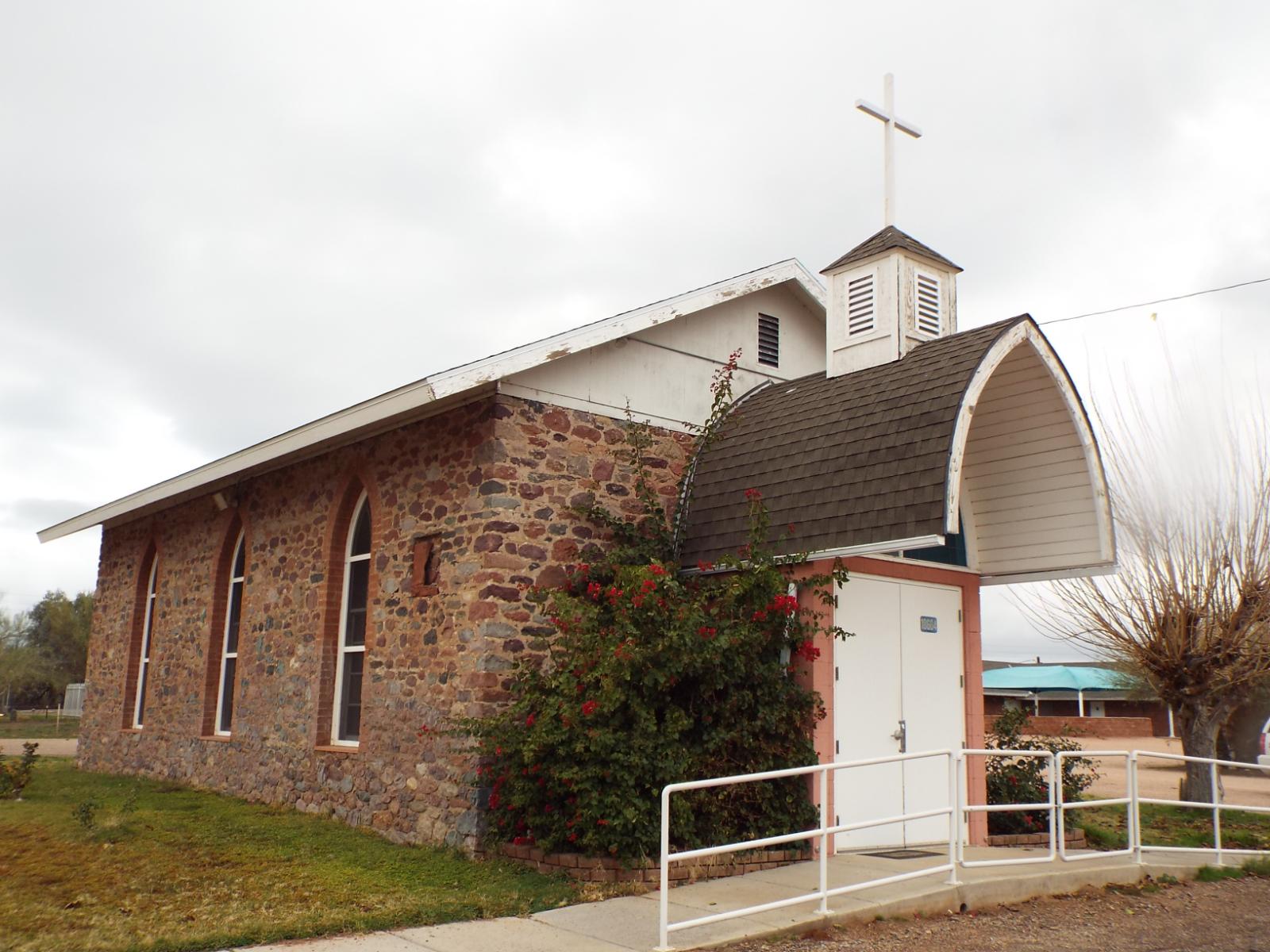
Why are people willing to pay so much to live here? What’s special about it?
Fort McDowell attracts buyers seeking exclusive desert living on the Yavapai Nation with stunning mountain views, privacy, and unique cultural heritage. The community offers luxury custom homes, casino amenities, and authentic Sonoran Desert experiences in a distinctive setting. Buyers value the combination of exclusivity, natural beauty, and cultural significance that creates a one-of-a-kind Arizona living experience.
The area’s limited development and pristine desert setting provide privacy and natural beauty that’s increasingly rare in the Phoenix metropolitan area. Fort McDowell’s unique location, cultural heritage, and exclusive character justify premium prices for buyers seeking extraordinary desert living experiences.
How Fort McDowell Rose to Prominence
Fort McDowell was established as a military post in 1865 to protect settlers and maintain peace with local Apache tribes during Arizona’s territorial period. The fort served as a strategic outpost along the Verde River until it was abandoned in 1890 after conflicts subsided and the area became more settled.
The area later became part of the Fort McDowell Yavapai Nation reservation, established in 1903. Modern development has been carefully controlled by the tribal government, creating exclusive residential opportunities that preserve the area’s natural character and cultural heritage while providing luxury amenities including casino gaming and resort facilities.
3 Interesting Tidbits
1. Military Heritage – Historic Fort McDowell served as an Army post from 1865-1890, with preserved structures and archaeological sites that reflect Arizona’s territorial military history.
2. Yavapai Nation – The community sits on the Fort McDowell Yavapai Nation reservation, providing unique cultural heritage and tribal governance that shapes development and community character.
3. Verde River Setting – The location along the Verde River provides rare riparian habitat and recreational opportunities in an otherwise desert environment.
3. Cave Creek – 158% Home Price Increase Since 2010
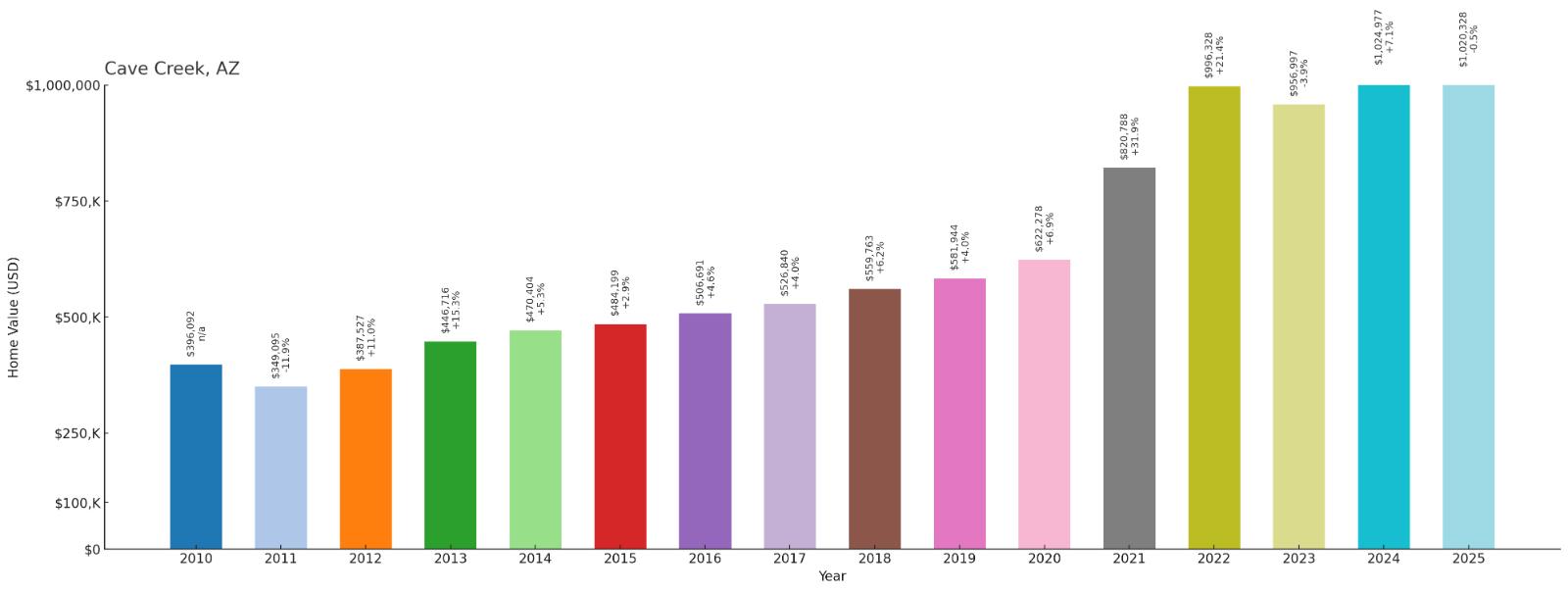
- 2010: $396,092
- 2011: $349,095
- 2012: $387,527
- 2013: $446,716
- 2014: $470,404
- 2015: $484,199
- 2016: $506,691
- 2017: $526,840
- 2018: $559,763
- 2019: $581,944
- 2020: $622,278
- 2021: $820,788
- 2022: $996,328
- 2023: $956,997
- 2024: $1,024,977
- 2025: $1,020,328
Cave Creek exhibits exceptional growth with home values more than doubling from an already elevated 2010 baseline of around $396,000. The desert town maintained steady appreciation through the 2010s before experiencing explosive growth during 2020-2022, when prices surged from around $622,000 to nearly $996,000. Current values above $1 million firmly establish Cave Creek among Arizona’s most expensive communities.
Why Cave Creek?
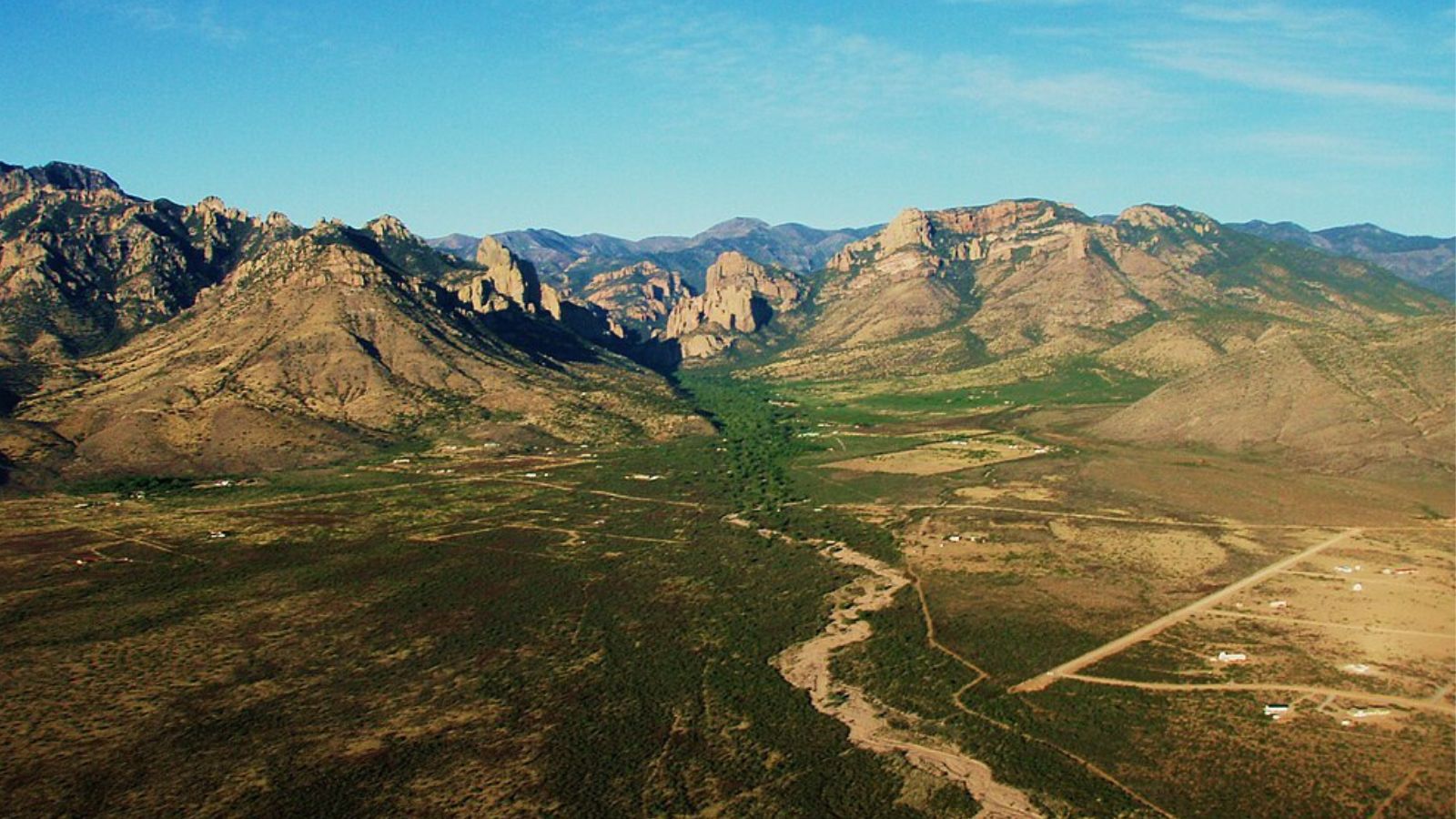
Why are people willing to pay so much to live here? What’s special about it?
Cave Creek attracts buyers seeking authentic Western character combined with luxury desert living on large lots north of Scottsdale. The town offers preserved cowboy heritage, custom homes, and stunning Sonoran Desert setting while maintaining proximity to upscale amenities. Buyers value the combination of Western authenticity, natural beauty, and exclusive character that creates a unique Arizona lifestyle.
The community’s commitment to preserving its Western heritage through architecture, zoning, and cultural events sets it apart from typical suburban development. Cave Creek’s authentic character, large lots, and desert beauty justify premium prices for buyers seeking distinctive Western living experiences with modern amenities.
How Cave Creek Rose to Prominence
Cave Creek was settled in the 1870s by miners, ranchers, and farmers attracted to the area’s natural springs and desert grazing land. The community developed around mining operations and later cattle ranching, maintaining its Western character through isolation and rugged terrain that limited development.
The town incorporated in 1986 to preserve its Western heritage and control development pressures from expanding Phoenix suburbs. Cave Creek’s commitment to maintaining authentic Western character while accommodating luxury development has created a unique community that attracts buyers seeking genuine frontier atmosphere with modern conveniences.
3 Interesting Tidbits
1. Western Heritage – Cave Creek preserves authentic Western character with historic saloons, cowboys bars, and Western shops that maintain the town’s frontier atmosphere.
2. Desert Caballeros – The community hosts annual Western events including rodeos and cowboy gatherings that celebrate and preserve Arizona’s ranching heritage.
3. Large Lot Living – Zoning requirements for large lots preserve the area’s rural character while accommodating luxury custom homes in authentic desert settings.
2. Carefree – 160% Home Price Increase Since 2010

- 2010: $487,153
- 2011: $474,657
- 2012: $530,920
- 2013: $583,630
- 2014: $623,822
- 2015: $628,580
- 2016: $659,749
- 2017: $668,885
- 2018: $698,721
- 2019: $727,145
- 2020: $772,117
- 2021: $1,026,991
- 2022: $1,253,415
- 2023: $1,201,254
- 2024: $1,252,452
- 2025: $1,268,367
Carefree demonstrates exceptional appreciation with home values more than doubling from an already elevated 2010 baseline of around $487,000. The luxury desert town maintained steady growth through the 2010s before experiencing dramatic acceleration during 2020-2022, when prices jumped from around $772,000 to over $1.25 million. Current values above $1.26 million establish Carefree as Arizona’s second-most expensive community.
Why Carefree?
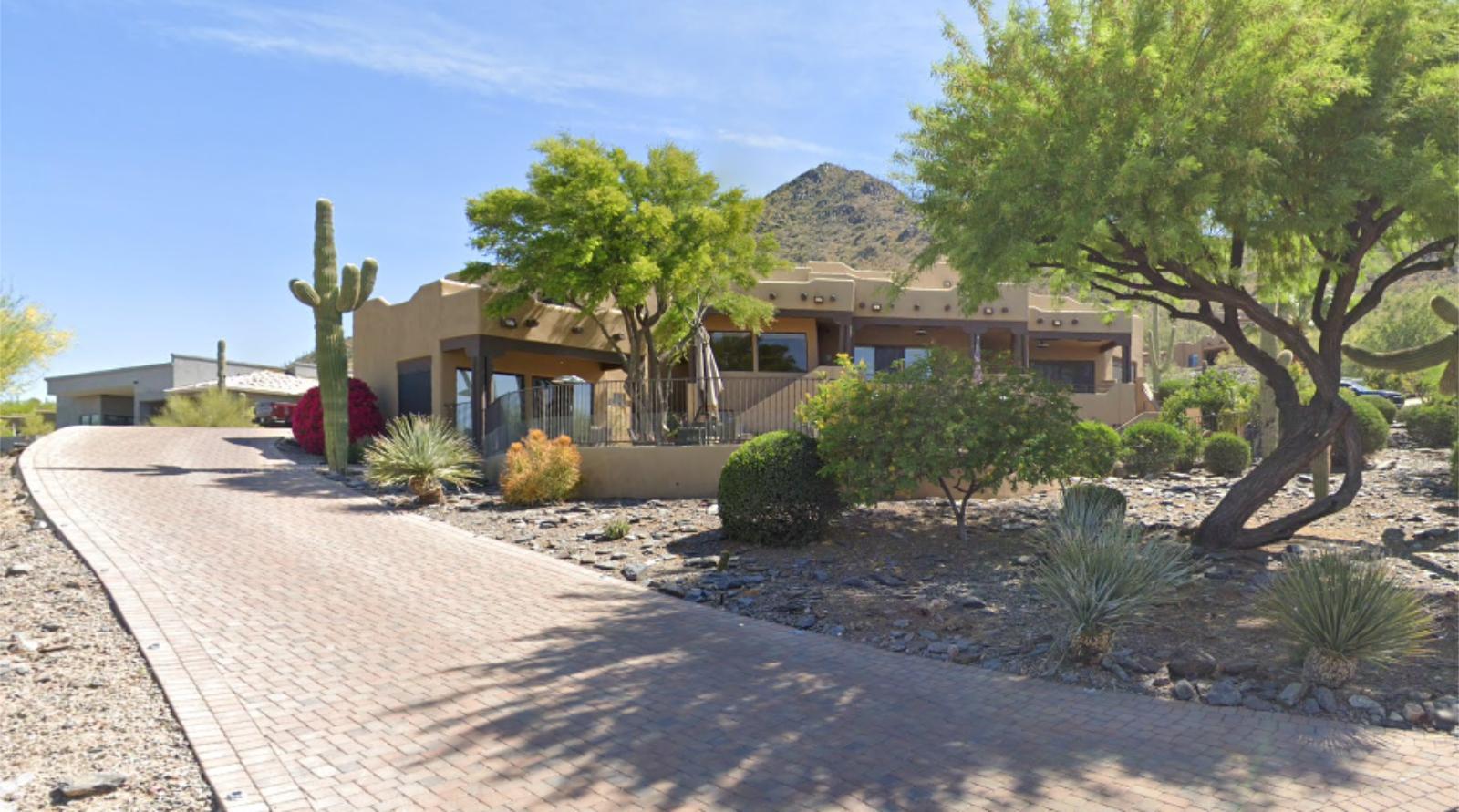
Why are people willing to pay so much to live here? What’s special about it?
Carefree attracts buyers seeking exclusive desert luxury with stunning mountain views, custom architecture, and sophisticated amenities north of Scottsdale. The town offers privacy, natural beauty, and upscale living while maintaining small-town character and artistic heritage. Buyers value the combination of exclusivity, scenic setting, and cultural attractions that create a premium desert lifestyle.
The community’s planned development preserves desert character while providing luxury amenities including golf courses, spas, and fine dining. Carefree’s unique combination of natural beauty, artistic culture, and exclusive development justifies premium prices for buyers seeking Arizona’s most sophisticated desert living experiences.
How Carefree Rose to Prominence
Carefree was developed in the 1950s as a planned luxury community designed to take advantage of spectacular Sonoran Desert scenery and mountain views. The development emphasized preservation of natural desert landscapes while creating an exclusive residential environment with recreational and cultural amenities.
The town incorporated in 1984 to maintain control over development and preserve its character as a luxury desert destination. Carefree’s master-planned approach, combined with its scenic setting and proximity to Scottsdale, established it as one of Arizona’s premier luxury communities attracting affluent residents seeking exclusive desert living.
3 Interesting Tidbits
1. Sundial Square – The town features a unique sundial and shopping plaza that serves as the community center and reflects Carefree’s artistic and cultural character.
2. Desert Architecture – Carefree showcases distinctive Southwestern architecture that harmonizes with the natural desert landscape and mountain setting.
3. Luxury Resorts – The community hosts world-class resorts and spas that add prestige and amenities while supporting the local luxury lifestyle economy.
1. Paradise Valley – 189% Home Price Increase Since 2010

- 2010: $1,092,618
- 2011: $986,451
- 2012: $1,102,154
- 2013: $1,305,755
- 2014: $1,413,026
- 2015: $1,393,057
- 2016: $1,388,039
- 2017: $1,418,176
- 2018: $1,482,328
- 2019: $1,500,798
- 2020: $1,602,723
- 2021: $2,150,641
- 2022: $2,807,491
- 2023: $2,619,734
- 2024: $2,866,872
- 2025: $3,160,227
Paradise Valley stands alone as Arizona’s most expensive community, with home values nearly tripling from an already extraordinary 2010 baseline of around $1.09 million. The exclusive enclave maintained steady appreciation through the 2010s before experiencing unprecedented growth during 2020-2022, when prices surged from around $1.6 million to over $2.8 million. Current values above $3.16 million establish Paradise Valley as Arizona’s undisputed luxury leader.
Why Paradise Valley?

Why are people willing to pay so much to live here? What’s special about it?
Paradise Valley attracts the ultra-wealthy with its exclusive estates, world-class resorts, and stunning mountain views between Phoenix and Scottsdale. The town offers ultimate privacy, custom luxury homes, and sophisticated amenities while maintaining strict zoning that preserves desert character. Buyers value the combination of exclusivity, natural beauty, and prestige that creates Arizona’s most coveted addresses.
The community’s reputation as a celebrity hideaway and luxury destination supports premium prices for buyers seeking the ultimate in desert living. Paradise Valley’s combination of natural splendor, exclusive development, and world-class amenities justifies the highest real estate values in Arizona.
How Paradise Valley Rose to Prominence
Paradise Valley was incorporated in 1961 as an exclusive residential community designed to preserve the natural desert landscape between Camelback and Mummy Mountains. The town was created by affluent residents seeking to maintain large lots, luxury development, and strict zoning controls that would preserve the area’s character.
The community’s strategic planning emphasized low-density development, preservation of mountain views, and accommodation of luxury resorts that enhanced the area’s prestige. Paradise Valley’s commitment to exclusivity, combined with its spectacular setting and proximity to Phoenix and Scottsdale, established it as Arizona’s premier luxury destination attracting celebrities, executives, and ultra-wealthy residents.
3 Interesting Tidbits
1. Celebrity Enclave – Paradise Valley has been home to numerous celebrities, business leaders, and politicians who value the privacy and luxury lifestyle the community provides.
2. Resort Destination – The town hosts several world-famous luxury resorts including the Four Seasons and Ritz-Carlton that add international prestige and amenities.
3. Mountain Views – Strict development controls preserve spectacular views of Camelback Mountain, Mummy Mountain, and the surrounding Sonoran Desert landscape that define the community’s character.

